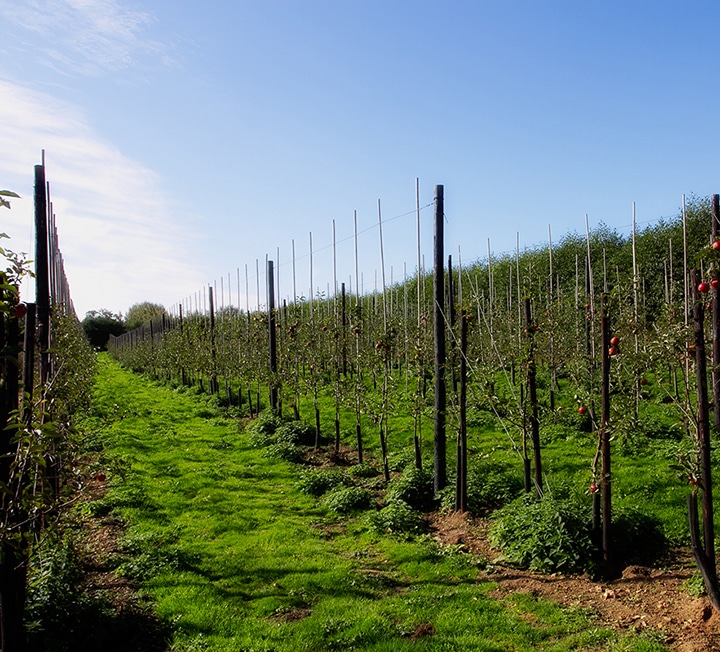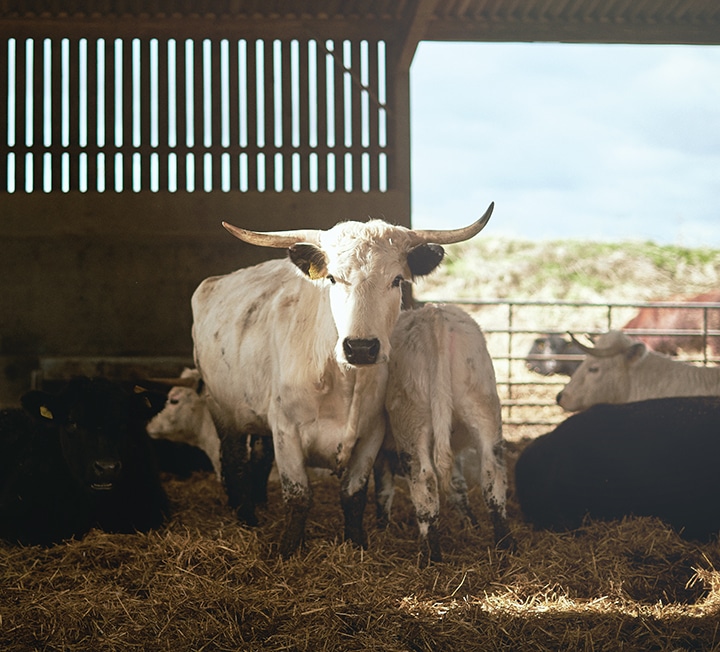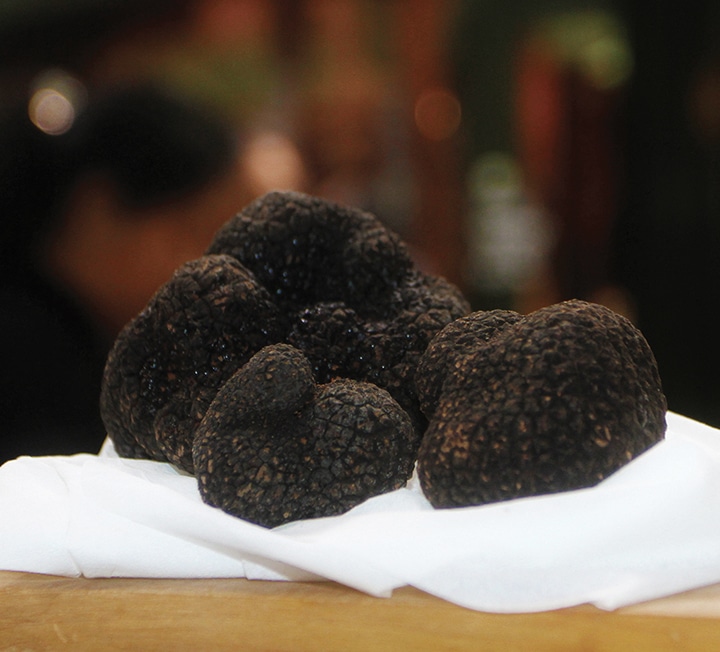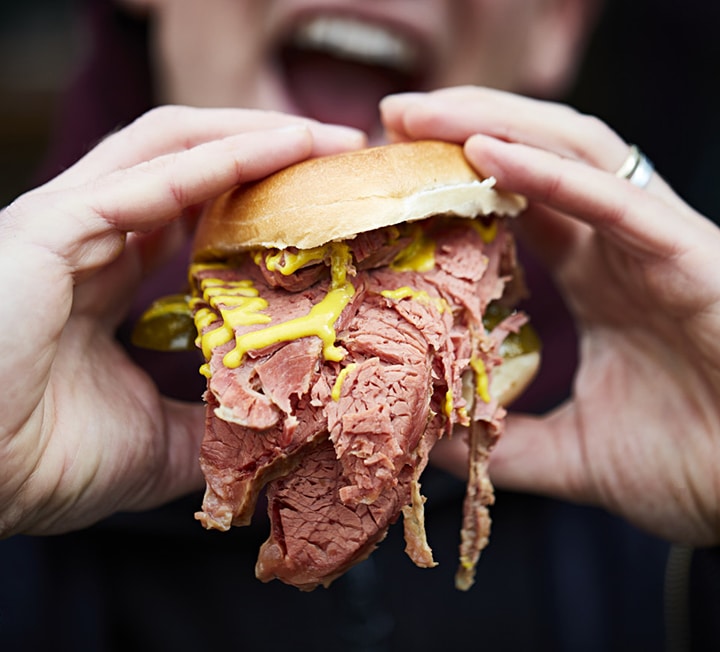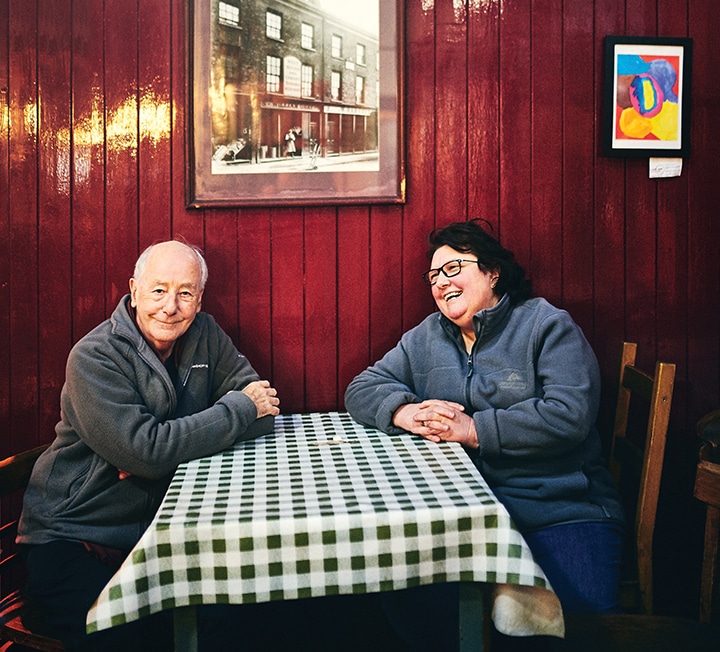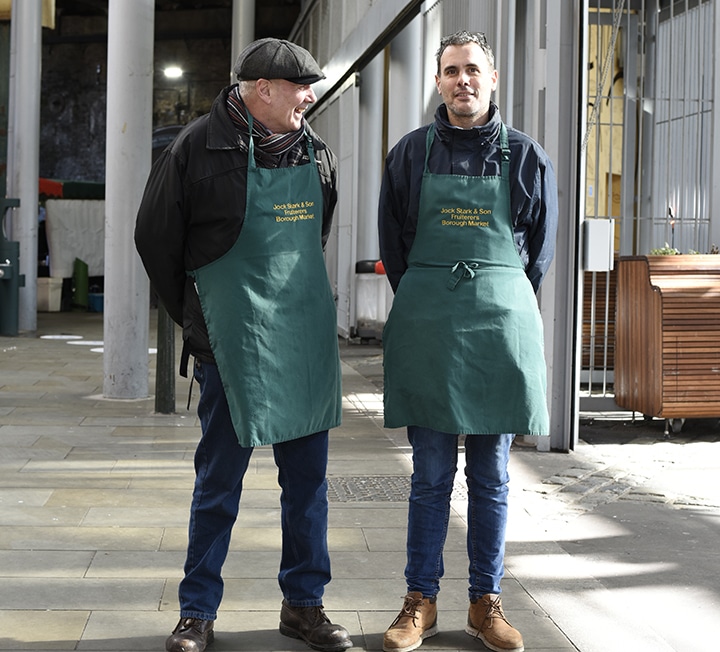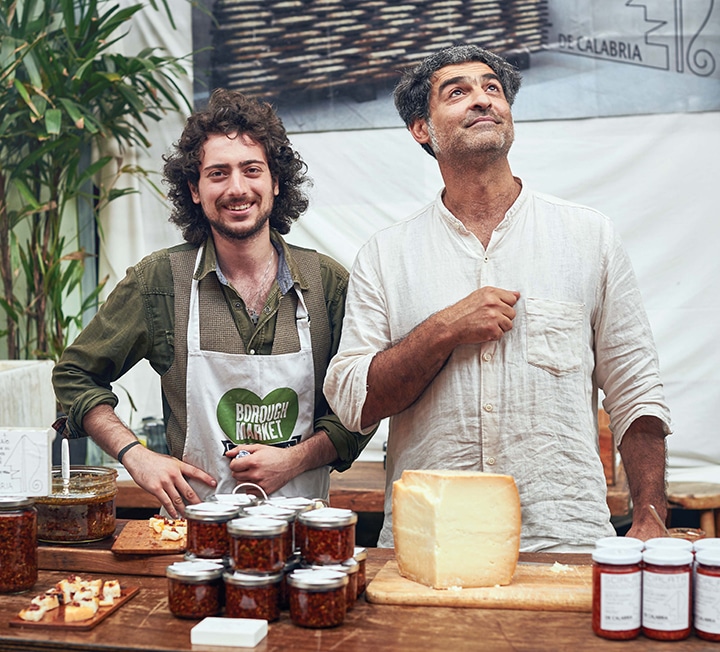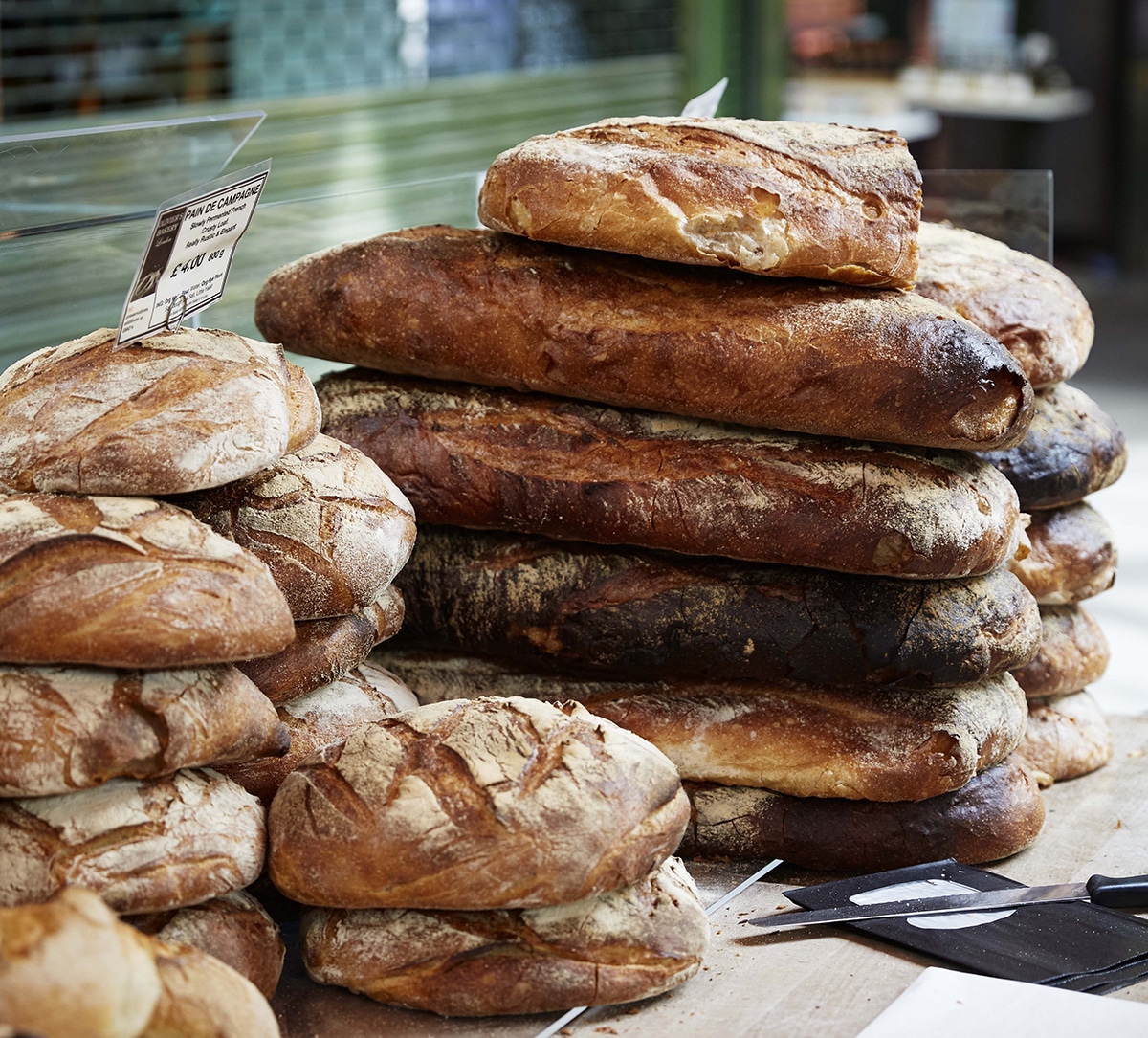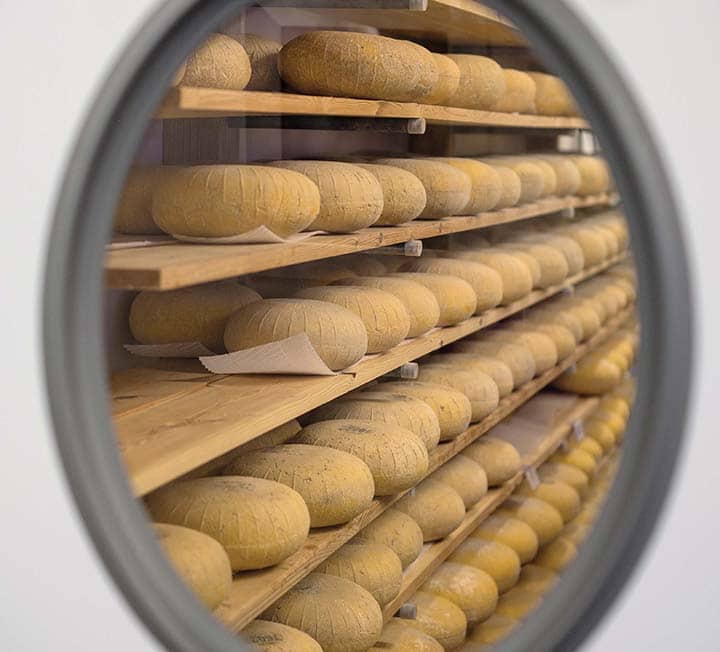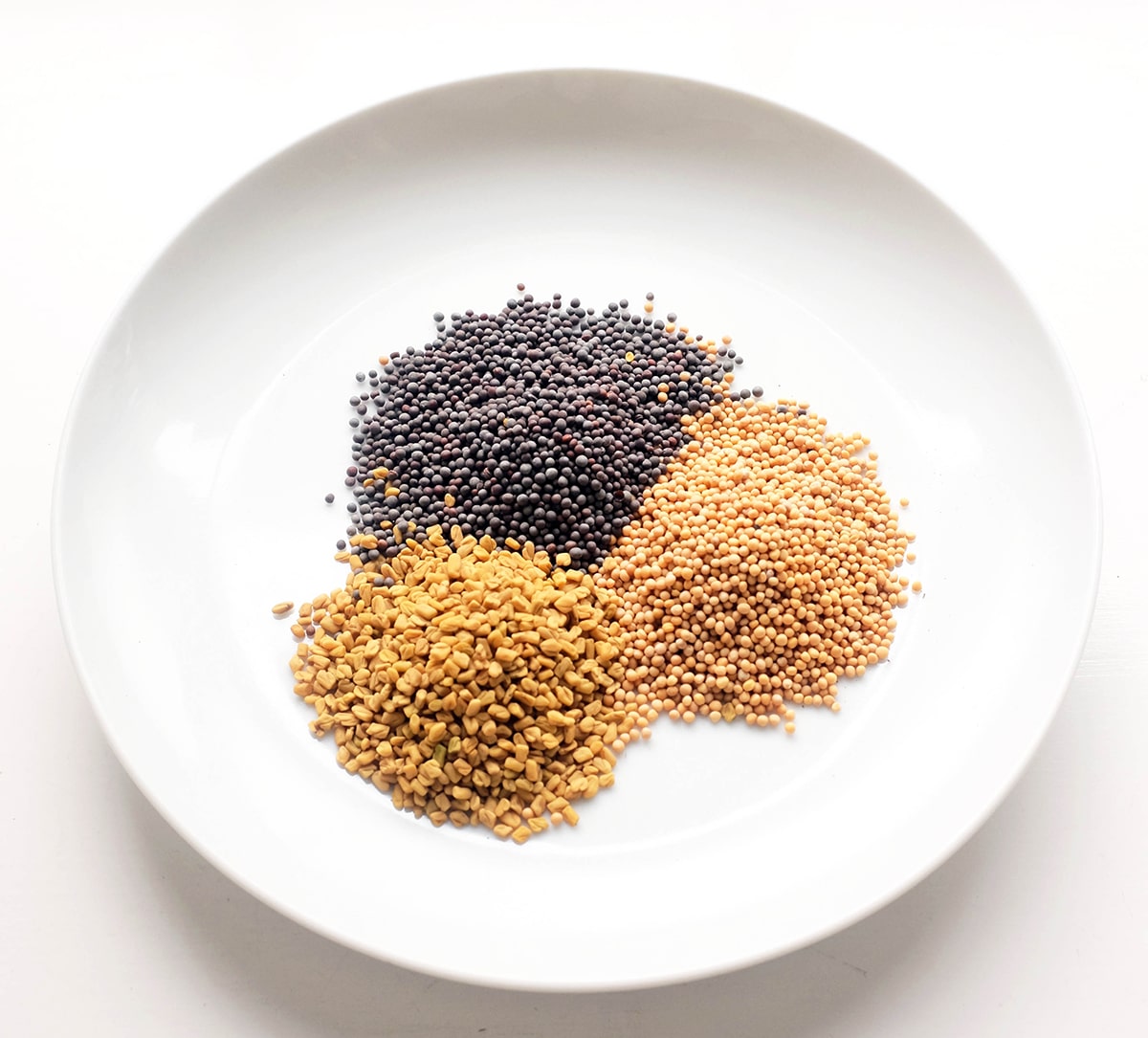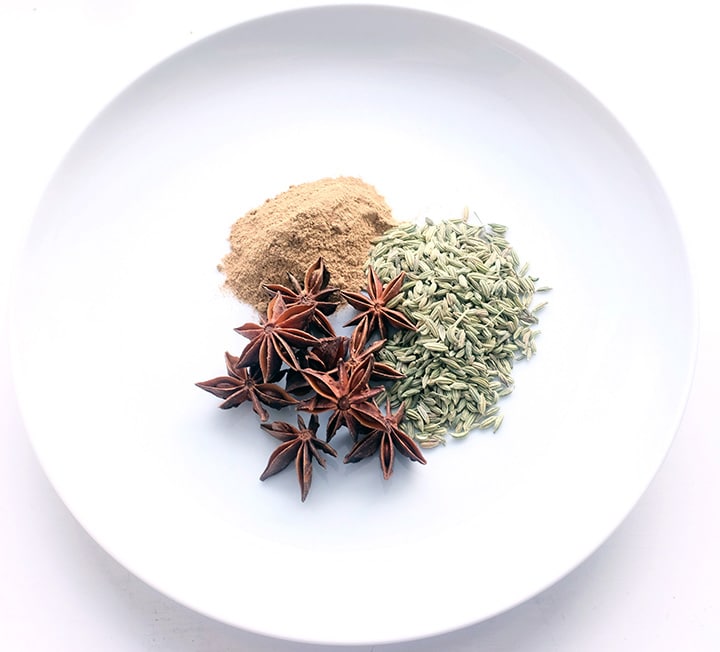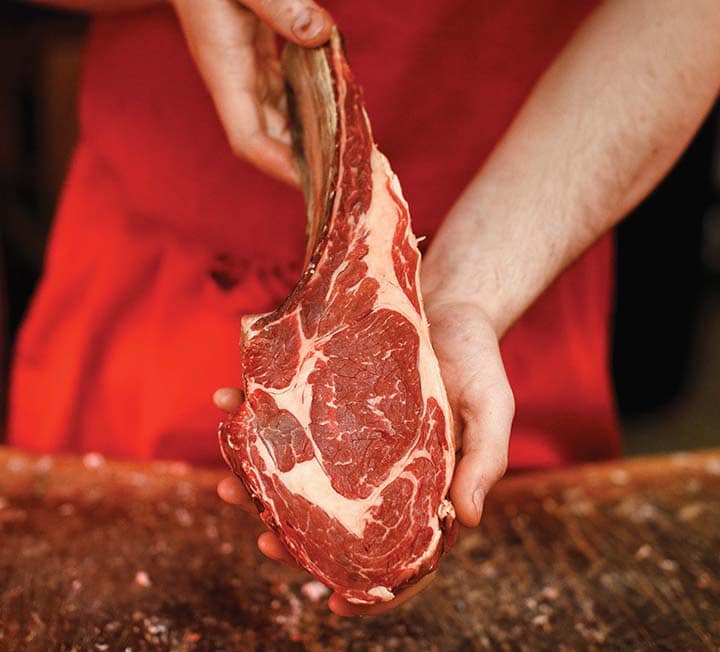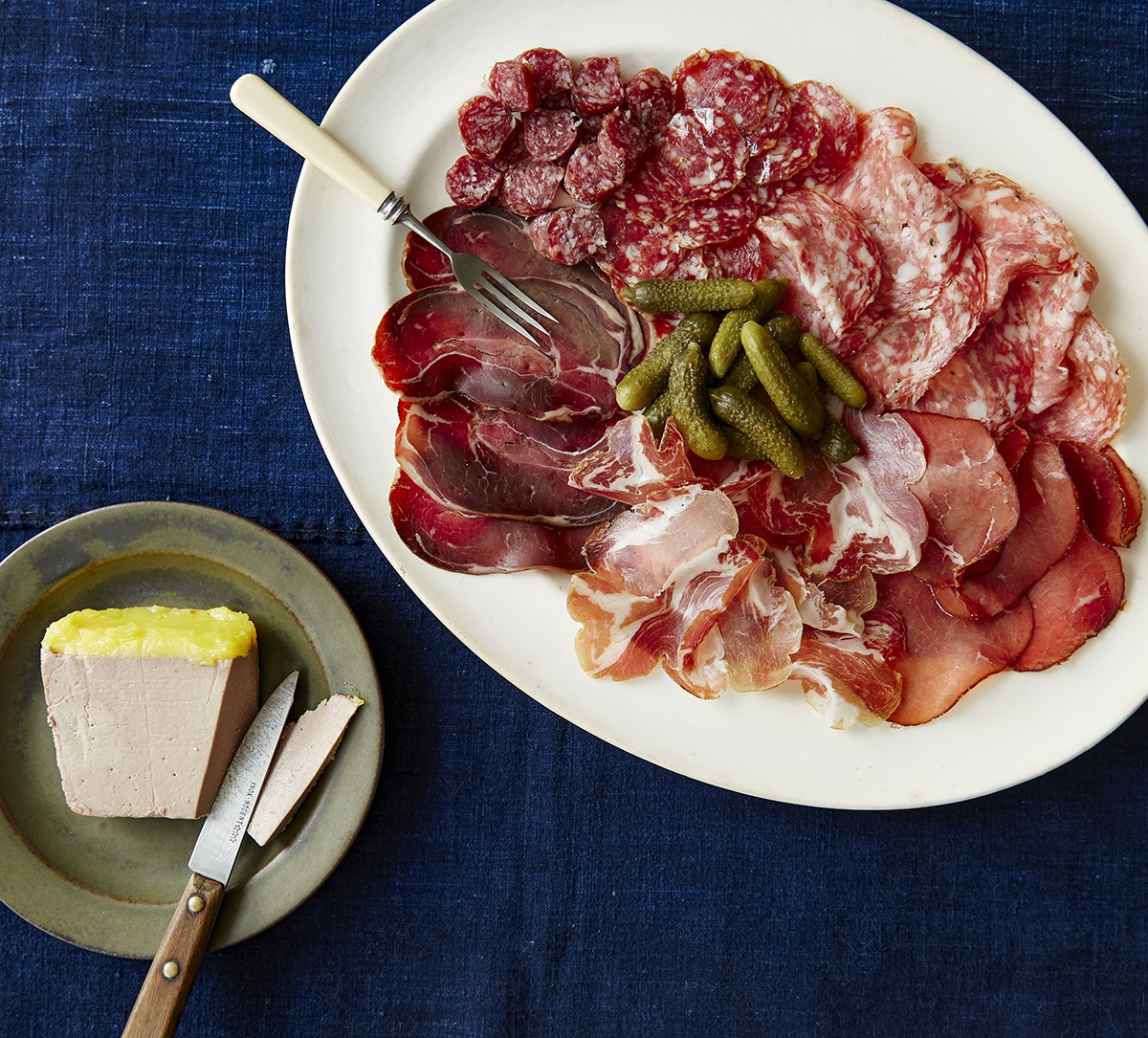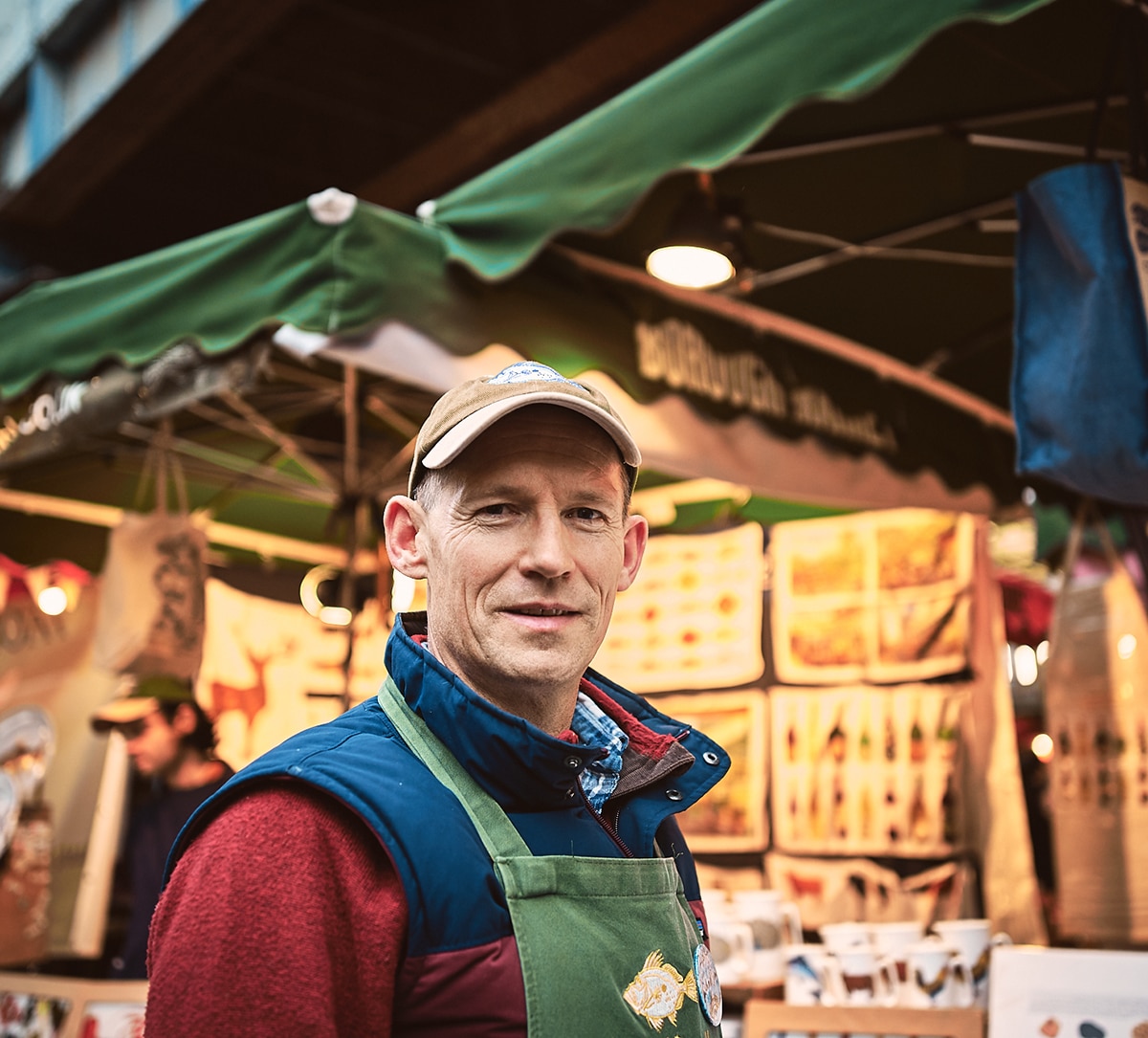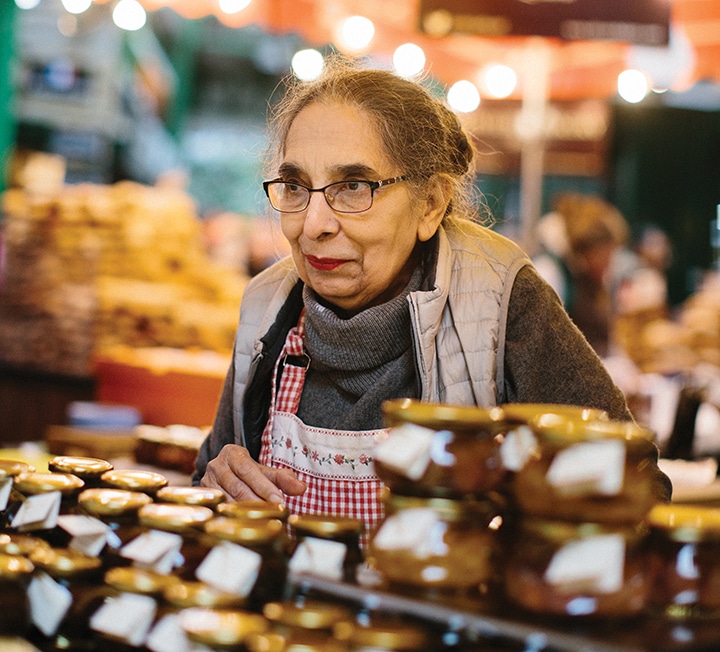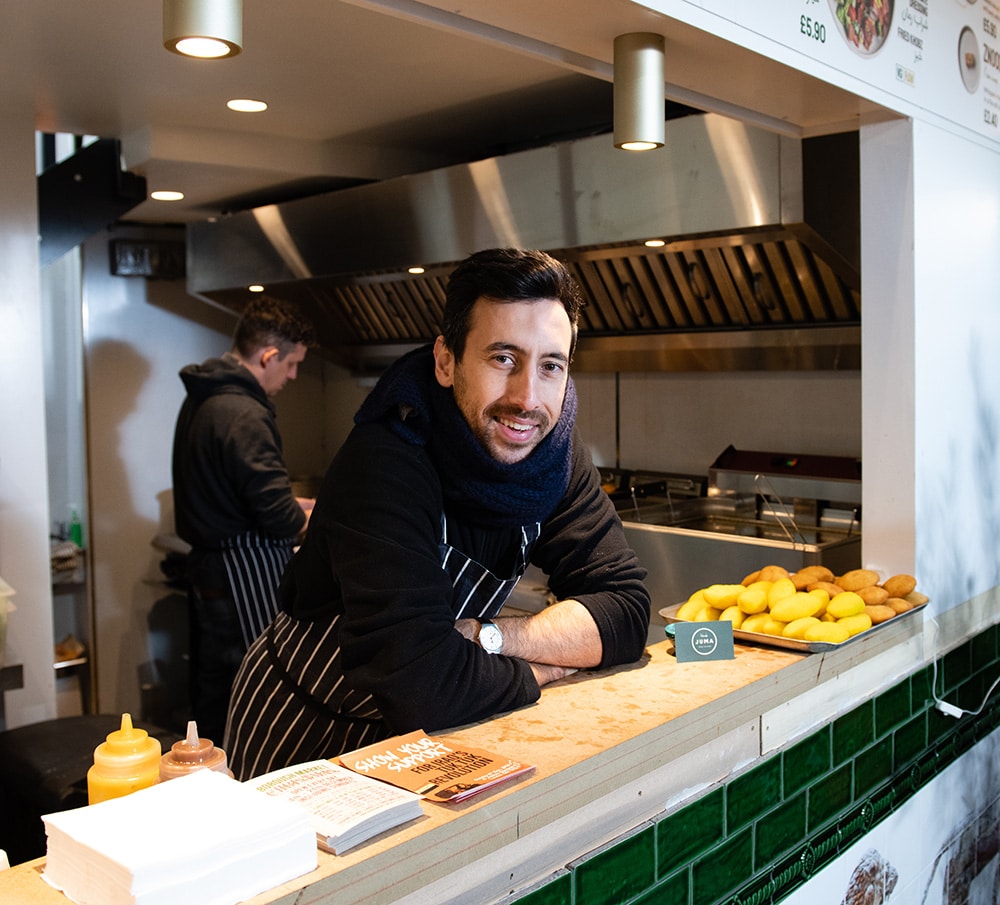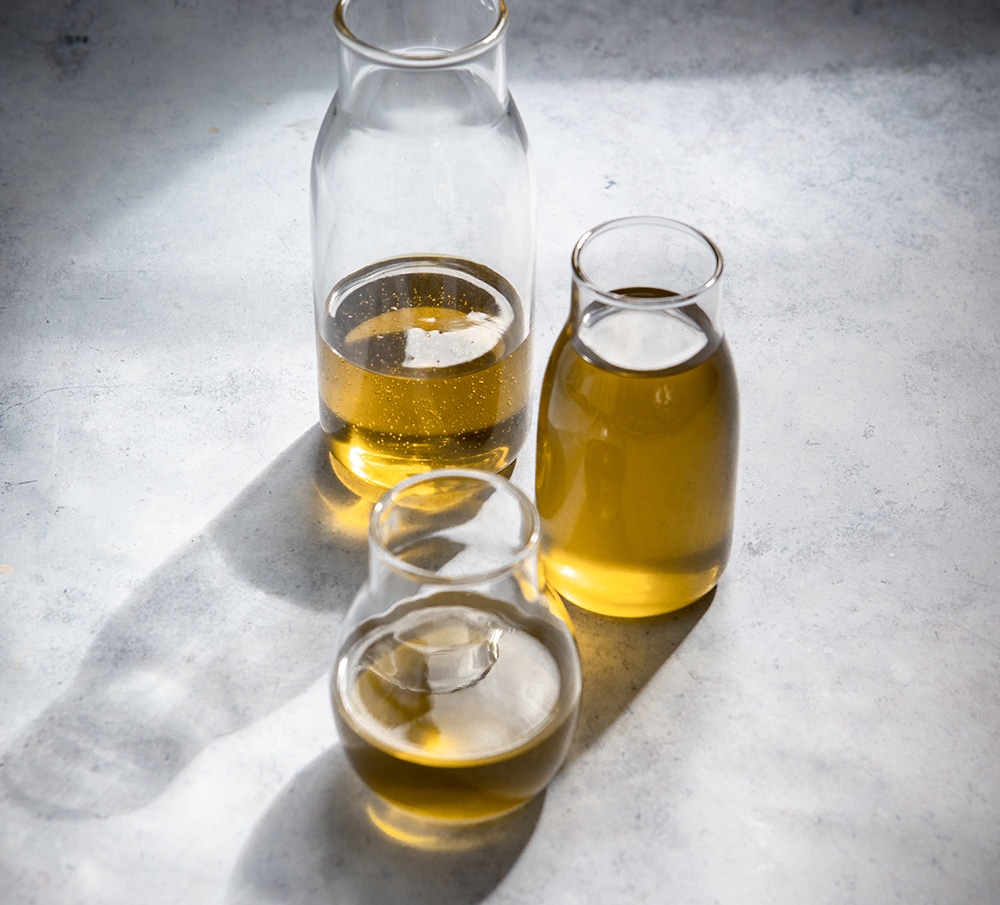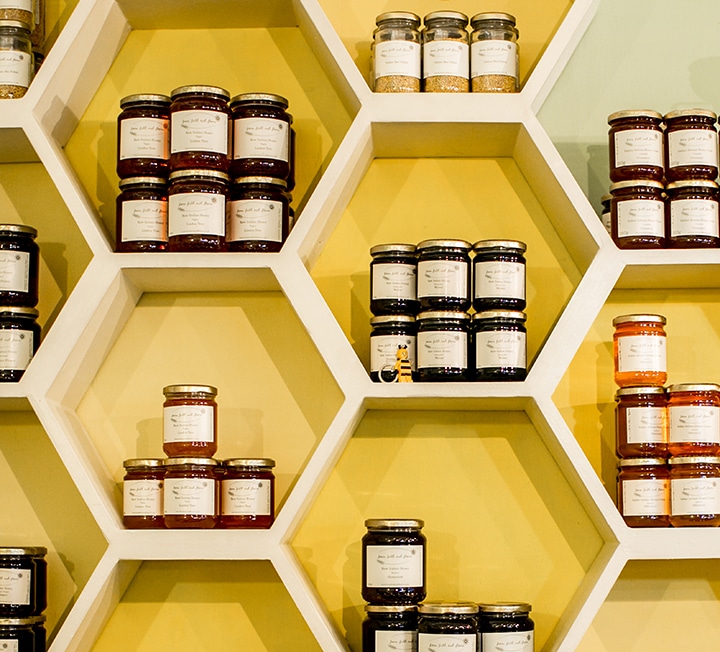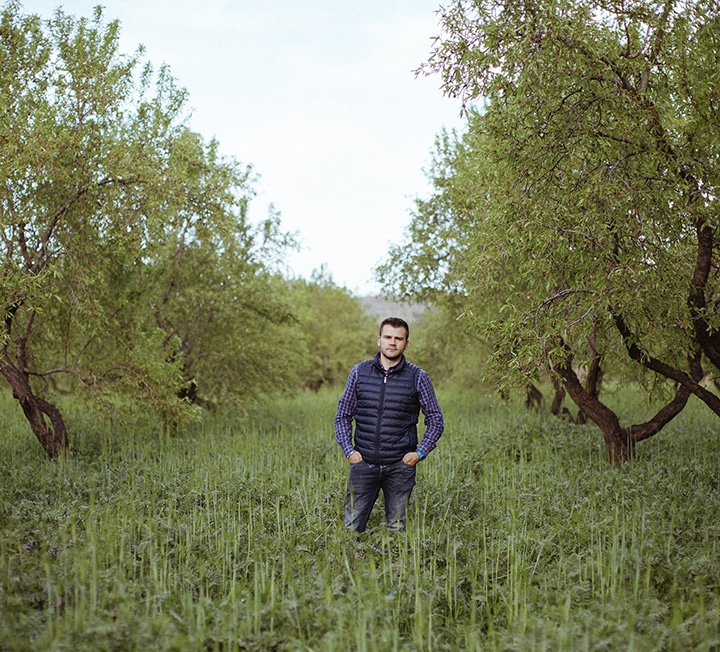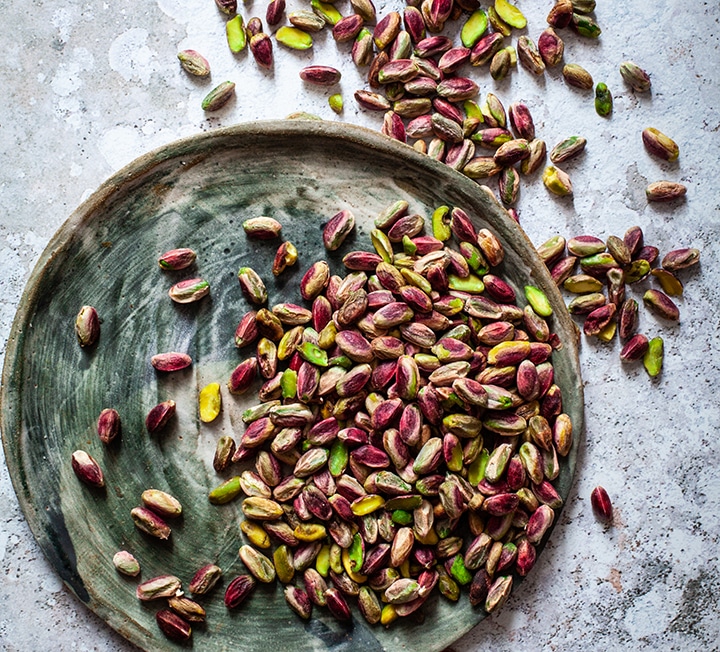Root and branch reform
In the hills of Andalucía, a pioneering foundation has been introducing farmers to the concept of ‘agroforestry’, a sustainable system of production in which arable crops and legumes are grown side by side with trees – a move away from the intensively-grown monocultures that do so much damage to precious agricultural land. Clare Finney pays a visit
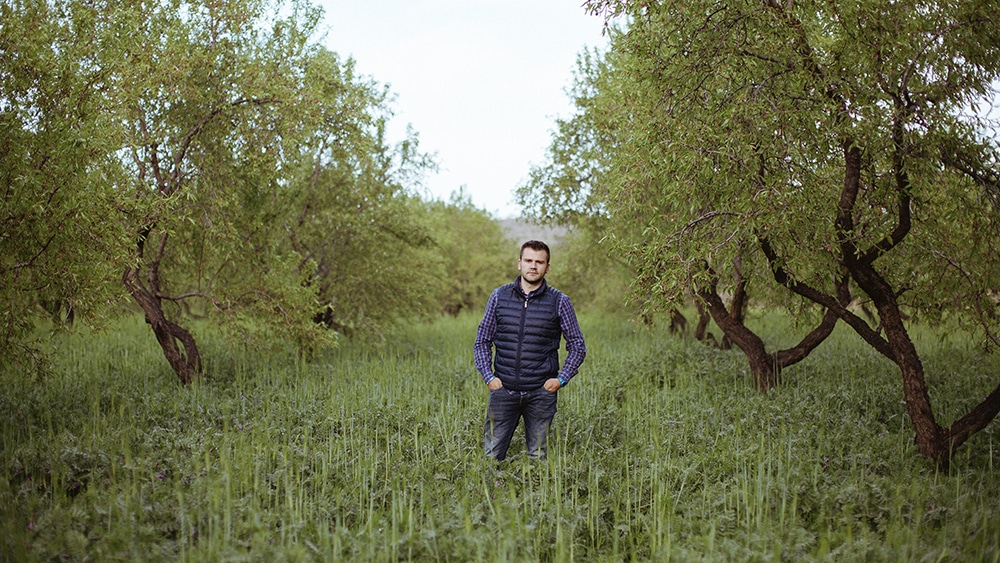

“FARMERS ARE BEGINNING TO REALISE THAT TILLING MIGHT BE THE REASON THEIR CROPS ARE STRUGGLING, NOT THE CURE”
Images: Joseph Fox
“To work with nature is art. It’s beautiful. Because nature is not lines – only curves,” says Frank Ohlenschlaeger, feelingly. We look out across the landscape – an El Greco of green and brown, enveloped in folds of grey mist – and back round at the caves we’re staying in, their shelves and cabinets built into nooks and crevices of undulating white walls. Frank’s company, Almendrehesa SL, is deeply involved in restoring these landscapes by reintegrating them with natural processes – a concept known as regenerative farming. The fruits (or, in fact, nuts) of his work can be found at Borough Market, thanks to Charles Tebbutt, whose Food & Forest stall sources almonds and walnuts from farms that use a form of sustainable agriculture called agroforestry.
“What Frank is doing here is fantastic,” says Charles. We’re in Andalucía, southern Spain, on the way to visit our first almond farm. Along the way, we pass field after field of windswept farmland and, tellingly, wind turbines, whirling away in the gusty sirocco winds. Working with the local AlVelAl initiative and Commonland – a global foundation which develops landscape restoration projects in areas vulnerable to erosion and climate change – Frank’s company has been instrumental in coordinating farmers, researchers, technicians and public bodies to drive forward one of Spain’s most ambitious regeneration schemes.
“He coordinates the different farmers who supply him, visits and advises interested farmers on how to farm more sustainably, and facilitates press visits like this that spread the word about landscape regeneration and agroforestry,” Charles explains. It’s these farmers who supply Food & Forest with those large, smooth-as-a-dime almonds that look and taste a million miles away from those you find in the supermarkets, most of which hail from California’s San Joaquin Valley.

On Charles’s Borough Market stall you’ll find photos comparing their nut farms to the barren wastelands left behind by California’s intensive agriculture. “It’s a false economy,” says Charles of their methods, which see huge swathes of land exploited in the name of productivity at the expense of flora and fauna. In the short term this means more almonds; in the long term this leads to desertification and its consequences – plummeting crop yields and devastating water shortages. Initiatives like AlVelAl and Commonland are growing in influence in Andalucía because farmers are “seeing the consequences of intensive production and wanting advice on how to stop them”.
Factor climate change into the equation – in the past three years this region has had 150 litres of rainfall instead of the expected 300 to 400 litres – and it is little wonder farmers are struggling. “You can see it all the way from Madrid to Granada,” observes Frank. “There it is all monoculture, and the soil is really eroding.”
Frank is not from Andalucía. He is not even Spanish – hailing instead from Germany. But his facility with the culture, language and people of this region is peerless. “I know all the farmers I work with here. It is not anonymous – we have good relationships.”
The philosophy behind Commonland is the invention of “a common land”, he continues. Regenerating the landscape is not an end but rather a means of creating a sustainable economy. “We need to inspire people, particularly young people, to live and work in this area, not disappear to big towns or to other countries.” The youth unemployment rate in Andalucía, he explains, is one of the worst in the country, “so the landscape restoration project must not happen in isolation. It must include young people. They must see the benefits. We call it the return of inspiration. The second return is a social return: to create jobs for all the people in the area, and ensure the opportunities and profit is not concentrated in one company.”
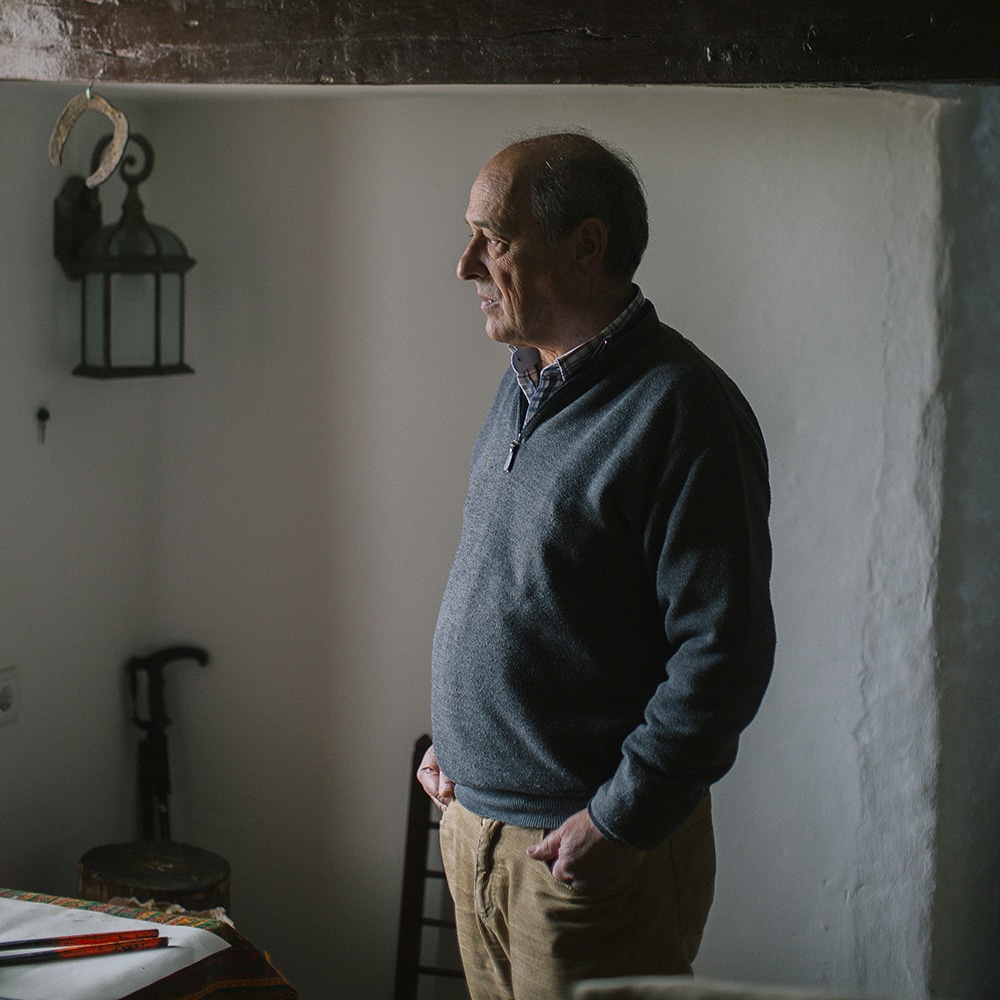
Miguel Angel Gómez Tenorio is a case in point. His is the first farm we visit: a family affair outside Granada, with almond trees coming softly into fruit, shedding their blossom. Where the land beneath the trees of a conventional almond farms would be brown and barren, his is verdant with cereals, herbs and legumes. “One of the reasons I like working with Frank and Miguel is that they are taking the benefits of their university education, then going out there and applying it to the real world – not sitting in their ivory towers,” says Charles, referring to the pair’s degrees in agroeconomics and agriculture respectively.
Standard almond agriculture dictates that fields be tilled, or ploughed very regularly, to direct all the soil’s goodness toward the almonds. Miguel takes a different tack: in September he plants his ground crop; come late spring, the crops are ploughed gently back into the soil. “The legumes are ‘nitrogen-fixing’ plants. Their nodules contain nitrogen-fixing bacteria that make nitrogen in the air available to the soil. It’s a miracle!” says Frank. The barley, meanwhile, supplies organic carbon. The result is what Miguel and Frank call “green manure”: plants which, while they grow, reduce erosion and run-off, then when ploughed into the soil provide nitrates, organic carbon, other nutrients and water.
Miguel is a farmer. But he is also a researcher and a professor at a nearby university, where he works during week days. One job informs the other: on the way around the farm we pass an experimental section where he is cultivating the almonds in different conditions and conducting long-term analysis of the results. One is green manure, one is traditional manure (sheep, cow and chicken faeces), one is bare, and one has a fast-acting type of compost.
“I want to analyse the quality of the fields over 20 years – not just the quality of the soil, but also the quality of the almonds,” he tells us. Initially most farmers come to Frank because their land is suffering, or because he pays a good rate, or both. But to be persuaded of the benefits and potential of agroforestry and sustainable agriculture, they need hard evidence – and that’s where people like Miguel come in. He is young, he is educated, but with his livelihood and that of his family bound up in the farm, he is also results-driven. “My interest in the project is 100 per cent.”
He takes out his phone and flicks to a photo of a stern-looking older man, his arms crossed and his legs planted in the same field we’re standing in. “This is my father. His philosophy is tillage. He’s not convinced by the idea of crop cover – he believes it competes with the almonds.” It’s a common problem in Andalucía – indeed in any region where farms are passed down through generations. The older, more traditional farmers believe tilling three or even four times a year is best practice, as it breaks up the dry soil and takes out the competition between ‘weeds’, as they see these ground plants, and the crop they want to cultivate. Farmers of the next generation, however – at least, those who still want to follow their parents into farming – are beginning to realise that tilling might be the reason their crops are struggling, not the cure for it. As a result, each farm we visit here is a patchwork of fields managed by the old guard, and those managed by their more pioneering daughters and sons.
“Many farmers don’t consider the financial costs of tilling, or its possible environmental impacts. Often they do it because their father did it, without really asking, ‘Is this good or bad?’” The problem with constant tilling, Frank continues, is that without the structure of organic matter there is nothing to hold the soil together and retain the rain water. It just runs away and as it goes, leaches the soil of nutrients and leaves it more susceptible to erosion by the region’s winds.
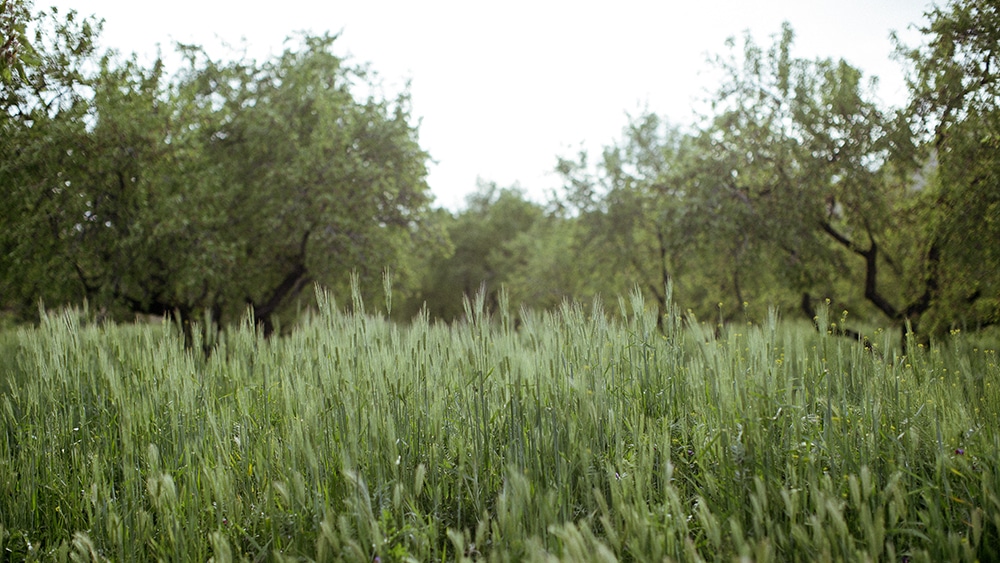
Miguel’s father is coming round to this perspective – in part persuaded, no doubt, by the lush greenery surrounding Miguel’s almond trees and, crucially, on the trees themselves. “I flooded these fields for just an hour last week,” Miguel says, pointing to an ancient Roman irrigation system that carries water to the village from the snow-capped Sierra Nevada mountains. The flood prompted a surge of greenery. By way of contrast, his father’s adjacent field of almond trees remains resolutely brown.
Many old-school farms have gone beyond the point where simply adding more artificial fertiliser can compensate for the levels of degradation. But to challenge such deep-rooted farming practices is “very difficult”, Frank says. There are farms you can point to as growing evidence of the benefits of agroforestry – Miguel’s is one – but there aren’t many, and few farmers have the time, interest or resources to explore alternative ways of scratching their living from the land.
It’s why Frank offers tempting prices; why his mind is constantly whirring as to how farmers can get the best out of sustainable agriculture, without compromising their income or their eligibility for EU subsidies. “The money is the first motivation to change. Later it is important that they see there are advantages to changing that go beyond money: that they see the fields improve, the crop improve in quantity and quality. I hope that, in time, when farmers have more knowledge of regenerative farming, it won’t just be the price that encourages them to continue.”
His work is beset with challenges. For a start, the EU rather bafflingly withholds its almond subsidy if a farmer also sells the crops grown between the nut trees. “You can plant what you want – barley, herbs, legumes – but you can’t sell them if you don’t want to lose your subsidies. It is stupid,” Frank says, irritably. He hopes this will change, and in the meantime has enlisted the help of a small processor of essential oils, who might be able to use the lavender and other herbs grown on the farm to make aromatics. Nor is that all Miguel’s lavender shrubs are good for.
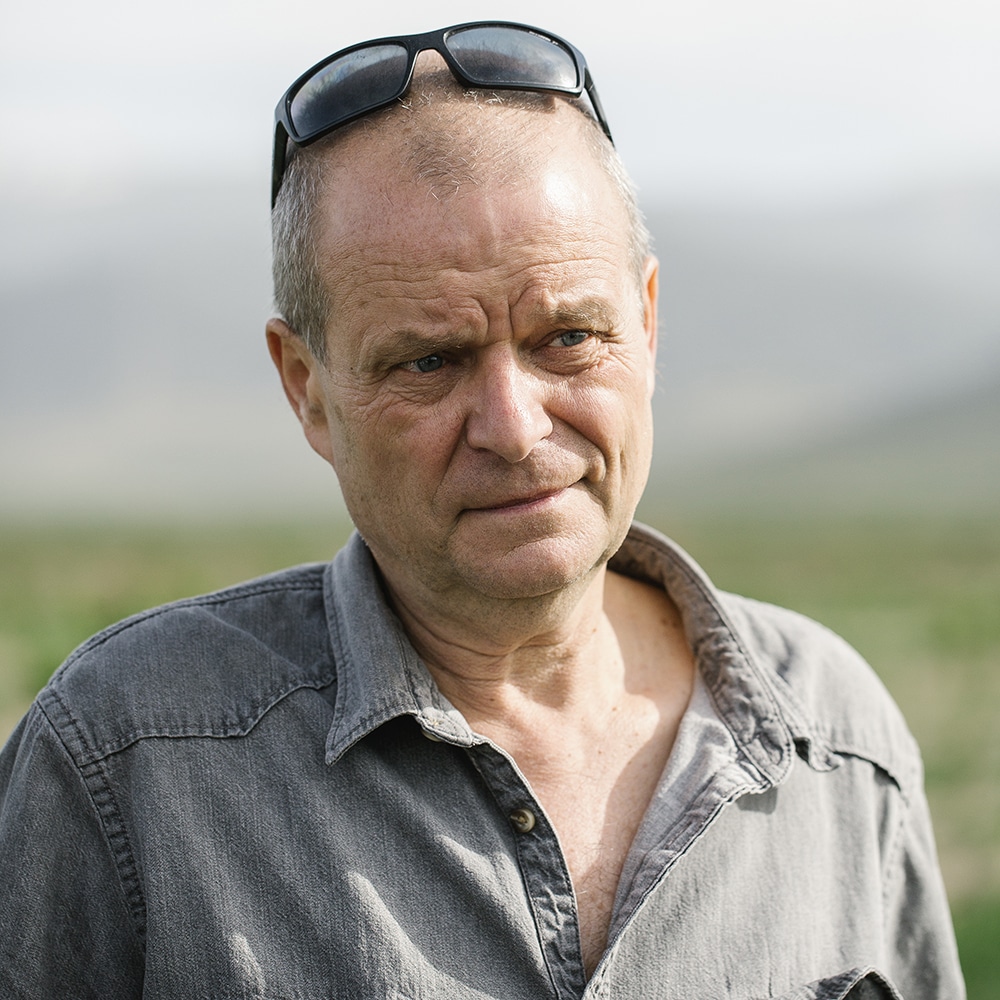
Following the lazy line of a bee from its feast in a lavender bud, I realise his farm is peppered with hives. “The beekeepers are happy because Miguel farms without pesticides, and we’re happy because the bees are pollinators,” Frank explains simply. “In the future I would like to sell almond honey.” But he needs more time, more money and crucially, more farmers. “The problem is most farmers think they don’t need bees, because new varieties of almond tree are self-pollinating. But you can still improve the harvest. We still need bees.”
To most of us, organic farming is something of a gold standard, implying harmony with the environment and healthier, more natural produce. To Frank, it’s a not a helpful categorisation. “The requirements for organic certification in Europe are the bare minimum. All it means is the producer has not used synthetic pesticides or fertilisers. You can still raze the ground four times a year. You can still use organic pesticides, which sounds okay until you realise how much more environmentally and financially effective it is to just encourage the natural predators that already exist.”
Similarly, the nitrates provided by the organic fertiliser will in fact stymie any nitrogen production from legumes. “Nature doesn’t fix nitrogen if it’s already there. It’s smarter than that.” There is such thing as bad organic farming, he continues, just as there is bad conventional farming. “Whereas for me, regenerative farming, ecological farming, is what very good organic farming should be.” It’s a sustainable system, it doesn’t depend on constant inputs. Of course, you need some sort of compost – green manure, sheep manure – but not frequent applications of organic fertiliser that’s been made elsewhere. “That shouldn’t be necessary. Farmers should be able to make their own compost, which is better-suited. Ecological farming is knowing the relationship between the climate, the plants, the soil and so on, respecting this relationship, and supporting it in your approach to farming.”
We move on, reluctantly: Miguel’s farm is an oasis. While the almonds have yet to ripen, the furry green buds smell full of promise. Our next stop, however, is what Charles describes as “textbook agroforestry”: a walnut farm that grazes indigenous sheep, with crop cover on the ground beneath the trees. It’s also an example of an EU agricultural subsidy breeding ingenuity, albeit inadvertently; the farmers were simply looking to get a forestry grant when they planted a field of walnut saplings a few years ago.
“A member of their family has a walnut farm in another part of Spain and gave them some,” explains Frank. It was only recently that they decided to harvest them and expand their collection to 20 acres, and “10, maybe 15 different varieties?” says farmer Rafael Ordínez (pictured top). The variations are too subtle to detect. Sampling a handful from his November harvest (“we sun-dry them for 15 to 30 days, outside. We’d love a solar powered dryer but” – he gives the ‘money’ shrug), I am hit by crunch after crunch of warm, creamy earthiness; a flavour which, unlike many walnuts, hovers tantalisingly on the line between bitter and sweet.
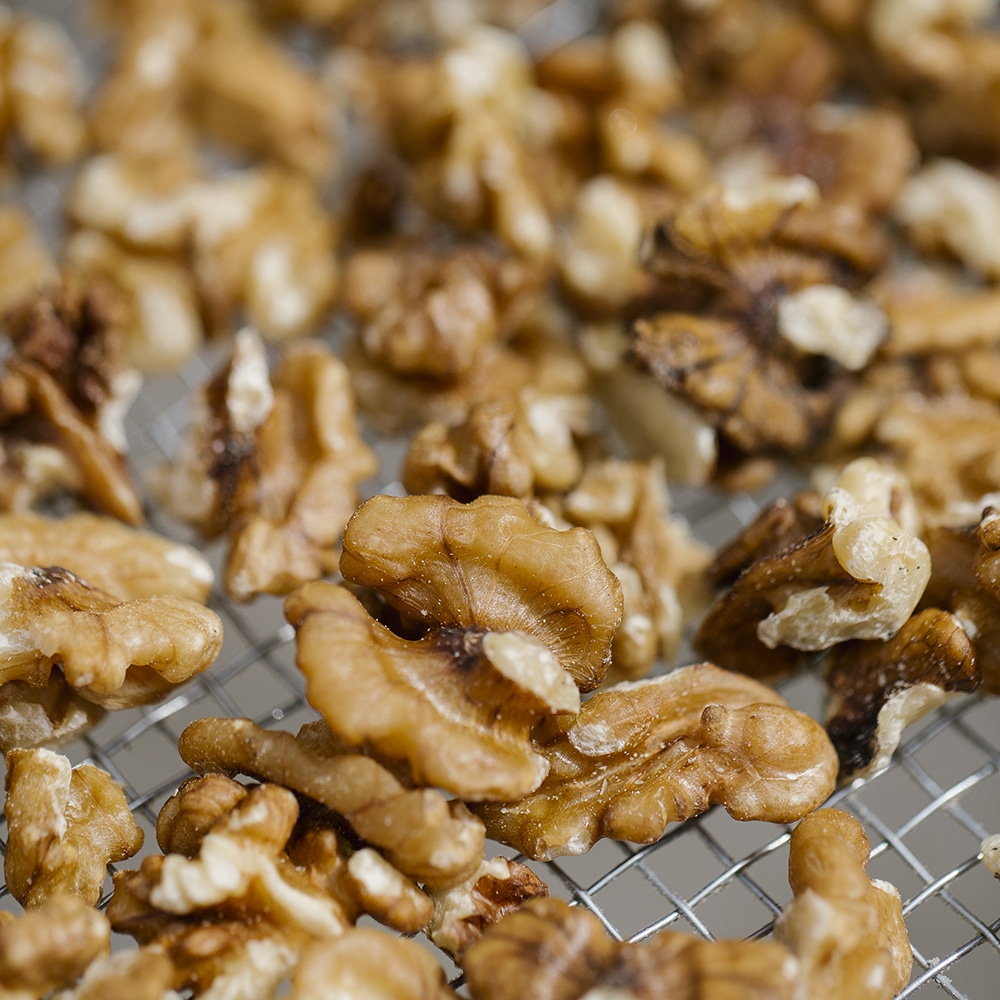
This is farming at its most simple, yet most effective. “The sheep do the work of a compost heap, except they do it in two days rather than six months,” explains Frank. The farmer tills just once a year, a policy implemented as a money-saving exercise, but continued once it became clear how much better the soil was as a result. Rafael Ordínez is not as young as Miguel. Nor does he have a degree in agriculture. “But he is university educated, he is interested, he is reading new research, he understands economy,” Frank explains.
Among the young people of Spain, and indeed elsewhere in Europe, the role of farmer has increasingly come to denote poor education – even small-mindedness. Redressing this perspective and repositioning farming as a professional career, worthy of respect and demanding knowledge and skills, is as fundamental to the Commonland and AlVelAl initiatives as wood pasture grazing. “We want to be proud of being farmers, and we want our sons and daughters to feel that as well.”
If their businesses are to have a chance of surviving into the next decade, these farmers need a younger generation: their understanding of marketing and trading, and their English. The absence of these skills among people of a certain age in Spain is, according to Frank, Franco’s legacy: “He was strongly isolationist. French and Spanish were the only languages he permitted.”
Are times changing? From the people we visit it’s hard for me to say, but I am heartened by the farmer who owns the caves in which we’re staying, overlooking Andalucía’s shifting landscape. Like many in this region, he supplements his living as a farmer with an additional income – in his case, a collection of beautifully converted caves. “In Spain we have young people who are very prepared; who are good and hardworking, who speak many languages,” he says passionately. “We have three members of our cooperative under 30,” says Frank. “Our biggest farmer is 27.”
They know about marketing, about the hard lines of packaging design and commerce, but they also care deeply about environment. Slowly – very slowly – they are bringing these skills back to the curving land from which they came.
Discover more
What it takes: Melton Mowbray pork pies
Paul Hartland of Mrs Kings Pork Pies on the challenges involved in the making of an east Midlands classic
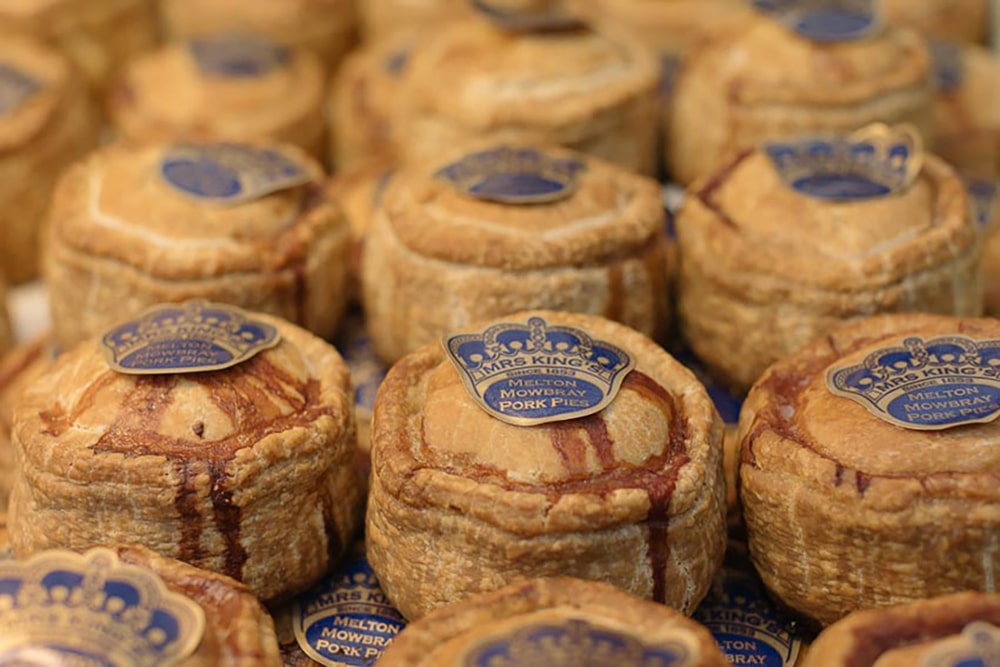

“THE KEY IS WORKING WITH GREAT SUPPLIERS. OUR PORK HAS BEEN SUPPLIED BY THE SAME PRODUCERS FOR 25 YEARS”
What are the origins of the Melton Mowbray pork pie?
Bakers in the Melton Mowbray area began producing these pies for gentlemen who had come up for the hunting. They would put them in their saddlebags and eat them while they were out. They were tasty and filling, and eating them wouldn’t interrupt the hunt for too long. They’ve come a long way since then.
In 2007, the Melton Mowbray pork pie was granted Protected Geographical Indication (PGI) status by the EU, recognising its historical, cultural and culinary importance. That was a really important moment for us. Like a lot of artisanal products, making these pies is about keeping the process simple but learning the skills and expertise to do so very, very well. There is no secret to our ingredients: all we use is flour, water, lard, salt, pork and a natural pork jelly. That simplicity can leave you vulnerable to cheap, poor quality imitations.
How do you maintain those standards?
The key is working with great suppliers. At Mrs Kings Pork Pies, our pork has been supplied by the same producers for 25 years. We believe it is really important to know where our pork has come from. We want to know that the pigs were raised well and that the slaughter and butchery have all been done to the highest standards. We have used the same flour suppliers for a similar length of time. The benefits go far beyond the trust that is vital to any relationship – it is also about understanding each other’s production methods and requirements. Our suppliers know exactly what we are looking for and the qualities we demand in our ingredients. Whether it is the meat, lard or flour, they know what is and is not acceptable to us.
Give us an example of this close relationship.
We use pork shoulder in our pork pies, as it has the best meat to fat ratio for roasting, which is in effect what is happening to the pork once it is in the oven. We used to bone the joints ourselves, but, as we got busier this became harder. After talking things over with the suppliers, they sent their best butchers over to learn how we handled and butchered the joints. We now trust them to bone the joints for us. As you can imagine, entrusting an outside company with such a vital process was a real step. We still examine every joint we get before accepting it, but we very rarely find any issue.
What is the process for making the pies?
In some ways, it is very much a scaled-up version of what would happen in a home kitchen. After the butchers break down the shoulders, the meat is put through a machine that chops rather than grinds it – you get a coarse mince, reminiscent of hand-chopped meat, where you can still see chunks of pork.
For every pie, a ball of pastry is shaped around a wooden block by hand – this is what the term ‘hand-raised’ refers to. We then put a ball of meat into the casing, then put the pastry lid on and crimp it, also by hand. This crimping makes the lid secure. as well as adding a decorative touch. Once assembled, we put the pies in the fridge, as pastry cooks better when cold. The pies then go into the oven straight from the fridge.
What happens once they are out of the oven?
We put them aside on baking trays, so that the pies can cool down and the meat can rest. Then we add the jelly that surrounds the meat. We make this by boiling pigs’ trotters for several hours to render out the gelatine. This gives you a lovely natural jelly with a deep pork flavour. We don’t have to do anything to it other than warm it up and pour it through a hole at the top of the pie into the gap that has developed.
Is this very different from large-scale industrial production?
The usual industrial method involves the casing and lids being shaped and attached by machines, with the pork filling being piped in. Melton Mowbray pies have to be baked free-standing, which leads to the characteristic bulge, whereas most commercial pies are baked in hoops to produce a regimented, uniformly shaped product. And finally, they’ll use a jelly made from commercial gelatine, with flavourings added to mimic the pork flavour. It is a very different thing to the pies we produce.
Where did you learn the skills to make these pies?
I was taught by my wife’s grandfather Kenneth Parr, which was a real privilege, as he was widely considered the country’s best master piemaker. It was he who bought the historic Mrs Kings company, which was known for the provenance and quality of its pies. As each of my brothers joined the business, they learned his methods as well. My son will join the company when he finishes his studies. He has been helping out since he was a boy and has that same passion.
So, the craft of the master piemaker is still alive?
Absolutely: ‘simple’ does not mean easy. It took me about five years to master all the processes necessary to produce high quality pork pies on a commercial scale. You need to understand how to handle the meat and cook it to its best, but you also have to understand working with pastry. You have butchers and bakers, but a good piemaker needs to combine the best of both skills. My role is to make sure that everything here is perfect, from the ingredients that come in to the pies that go out. It takes a lot of time and effort from everyone, but the first bite of one of our pies will convince you it is all worth it.
What it takes: Melton Mowbray pork pies
Paul Hartland of Mrs Kings Pork Pies on the challenges involved in the making of an east Midlands classic


“OUR LOVE OF FOOD MEANS SANDHYA AND I WERE ALWAYS LIKELY TO GET ON WELL, AND WE HIT IF OFF FROM THE BEGINNING”
Interviews: Viel Richardson / Image: Orlando Gili
Sandhya on Gaurav
Gaurav and I have known each other for about 10 years. My husband, who was best friends with Gaurav long before I met him, knew that I wanted to change my job and that Gaurav was in the same position. We both share a passion for food, and we would talk about it all the time, so my husband suggested we actually do something with that passion. Horn OK Please was the result. We decided we wanted to do Indian street food, which is reflected in the name – it’s a phrase you’ll see painted on the back end of vehicles in India.
Gaurav is always talking about food. If it’s not about something we are cooking, it will be about something else that’s gluten free and healthy – those are his food obsessions. Those and beer! He is an amazing chef and does most of the cooking for the business. He has a wonderful culinary imagination and is great at playing with tastes, textures and aromas, which is what I think makes our food exciting. Being surrounded by fresh produce at the Market is something that really inspires Gaurav – he loves the seasonality that Borough Market represents and tries to reflect that in the food. Where Gaurav is really brilliant is in his ability to incorporate these seasonal changes into what we regularly cook, rather than creating entirely new dishes.
Gaurav’s dedication is amazing. When I was on maternity leave, he worked all hours to keep things running smoothly. Not only is he a very good friend, but I feel like I have his complete support whenever I need it, which is very important.
The worst thing about working with Gaurav is the fact that he is always so relaxed. If something is getting me a bit stressed, it can be frustrating to look across and see him as the picture of calm. We get on very well, but we do argue a bit, which is why even though we both work on the stall, you will rarely see us working there at the same time! I would say the relationship is like a brother and sister.
Gaurav on Sandhya
Our shared love of food means Sandhya and I were always likely to get on well, and we hit if off from the beginning. But with her, it’s more than just about loving food, it’s about connecting with the customers. We have developed a real bond with many of them, and Sandhya has been central to that: she knows their names, their birthdays, what they do for a living. We have customers who have had children since they have been coming to us and now their kids are beginning to eat at the stall, which is really lovely.
Sandhya wants to make sure the customers understand our food as well as enjoying it – and that enthusiasm is infectious. Seeing her with the staff and customers is like watching an extended family enjoying themselves. It adds real colour and vibrancy to the Market.
The main things Sandhya brings to the business are drive and passion. Her work ethic is amazing. When she goes on holiday and I take on her duties, it reminds me of just how much she does in all areas of the business. It is one of the core reasons that the business has done so well.
Even though I do the cooking, Sandhya has a great palate and I completely trust her opinion. She is the first person to try any new recipe and if she doesn’t like it, I go back to the drawing board. We both go to India regularly and if either of us try something we like, we will see if we can use it in some way. While our food is vegetarian – and so am I – Sandhya definitely is not. She likes steak and really good hamburgers. That said, if I was choosing a place for a celebratory meal, it would have to be somewhere with good champagne and a great cheese board. Those are two of her favourite things.
What it takes: Melton Mowbray pork pies
Paul Hartland of Mrs Kings Pork Pies on the challenges involved in the making of an east Midlands classic


“THE DISH IS CLAIMED BY MALAYSIA AND SINGAPORE AND SLURPED FROM THAILAND TO INDONESIA AND BEYOND”
Illustration: Ed Smith
The origin of laksa is a bit slippery to pin down, just like the noodles that nourish this fragrant southeast Asian soup. Some etymologists believe the word laksa originates from an ancient Persian word for noodles, ‘laksha’ – a remnant of the centuries old trade links between the Middle East and islands of the Pacific. But the dish is claimed by Malaysia and Singapore as their own and slurped from Thailand to Indonesia and beyond. Variations are abundant, but united in a single common purpose: to fill the belly and comfort the soul.
A bowl of laksa comes brimming with treasures. Noodles intertwine with poultry, vegetables, seafood and/or eggs in an aromatic broth. Ingredients and seasonings vary, thanks to the Peranakan people, descendants of early Chinese migrants, who settled throughout the Malay archipelago and inscribed onto the dish the regional signatures of their new homelands.
On the island of Penang, for example, asam laksa resonates with sour Thai flavours like tamarind, while in Singapore the dish is sweet and rich with coconut milk and salty with dried shrimp. In Johor, meanwhile, laksa is more akin to curry.
This diversity offers a pleasing latitude to chefs. “I don’t ever use the word authentic; I just say it’s my family recipe,” explains Salina Campbell, founder of Borough Market’s Joli food stall, which serves up hundreds of bowls of vibrant Singapore laksa each week. Salina says fresh ingredients – not dried – are key. “We use fresh turmeric, fresh galangal, and fresh baby shallots – so much more expensive than dried, but worth it – which I cook from fresh. I also grind the chillies myself,” she says. “I use my great-grandmother’s recipe. She was a food trader at one of the first food markets in Penang.”
The secret to the vibrant flavour of Salina’s laksa? She attributes it in part to cooking her paste – made with shallots, galangal, lemon grass, tamarind, dried shrimp, star anise, mint, pandan leaves, chilli, candlenuts (for nutty richness) and olive oil (for health, she says) – in a clay pot. “The flavour is better than cooking it in a metal pan.” No surprise that laksa is among the richest, most delicious and comforting of all the bowl foods.
Paste
The all-important paste defines the flavour of laksa. A heady amalgam of dried spices, fresh herbs and other aromatics (which vary according to the region and style of laksa being prepared) are pounded to a paste, traditionally with a pestle and mortar.
Soup or gravy
This is made by frying off the paste (essential to avoid the taste of raw spices in the finished dish) and adding liquid – coconut milk and/or chicken or seafood broth. In some regions, pieces of chicken are cooked in the soup itself.
Noodles
These are cooked separately and added when the laksa is assembled: thick rice ribbons, delicate vermicelli, wheaten spaghetti or, if you’re lucky, more than one variety.
Add-ons
Appropriate additions are deliciously varied. Prawns, tofu and laksa leaves are commonly included. Other morsels added to the bowl might comprise boiled eggs, shrimp balls, fish cakes, cuttlefish, black pudding, mackerel and mint, topped off with a sprinkling of fried shallots.
Labour of love
Clare Finney visits Olivier’s Bakery to find out why the art of baking real bread demands skill, focus, feel and – perhaps above all else – love
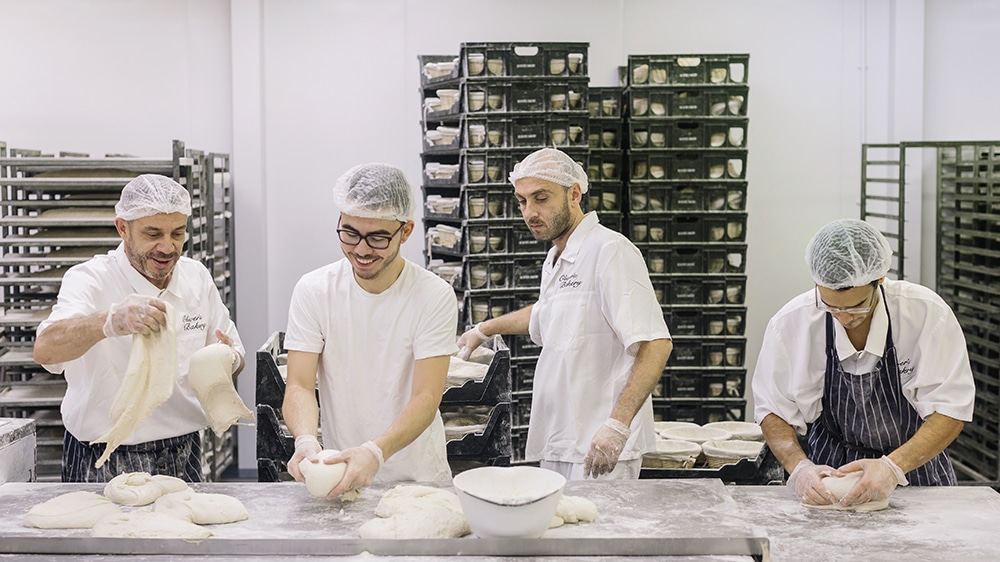

“BREAD IS FOR SHARING. BREAK BREAD AROUND A TABLE AND YOU WILL FEEL A REAL CONNECTION”
Images: Orlando Gili
“There’s no love in a roll,” proclaims Olivier Favrel, over the steady thwump-thwump of the mixer turning fat folds of dough. At first, I don’t understand him. Olivier is a baker: surely a bread roll inspires as much love in him as one of his large pain de campagne loaves? “Bread is for sharing. Break bread around a table, and you will feel a connection that’s quite different to sharing a salad or a chicken,” he explains simply. “Pay close attention, and you will see there is a difference between people passing bread to one another, and passing the salt.”
That’s the first reason you won’t find bread rolls on the Olivier’s Bakery stall at Borough Market. The second is more technical. “Good bread comes from slow fermentation. If you want to make good bread, don’t make 2,000 little rolls of it. It doesn’t work so well,” he says, the weight of 30-odd years’ baking experience resting comfortably beneath his assertion. You can make bread without slow fermentation – bread that’s not sourdough, that is – but “sourdough is the most beautiful way to make bread, and the most natural”. Of course, by sourdough Olivier strictly means bread that takes a full day to prove, using the bakery’s own starter culture, not the so-called sourdoughs you’ll find in certain supermarkets, produced at an industrial speed and quantity. “This is terrible,” he says, French rs rolling dramatically. “It is totally inappropriate and commercial. Sourdough is a slow process. You have to care, you have to focus – and there has to be a great connection between the baker and the bread.”
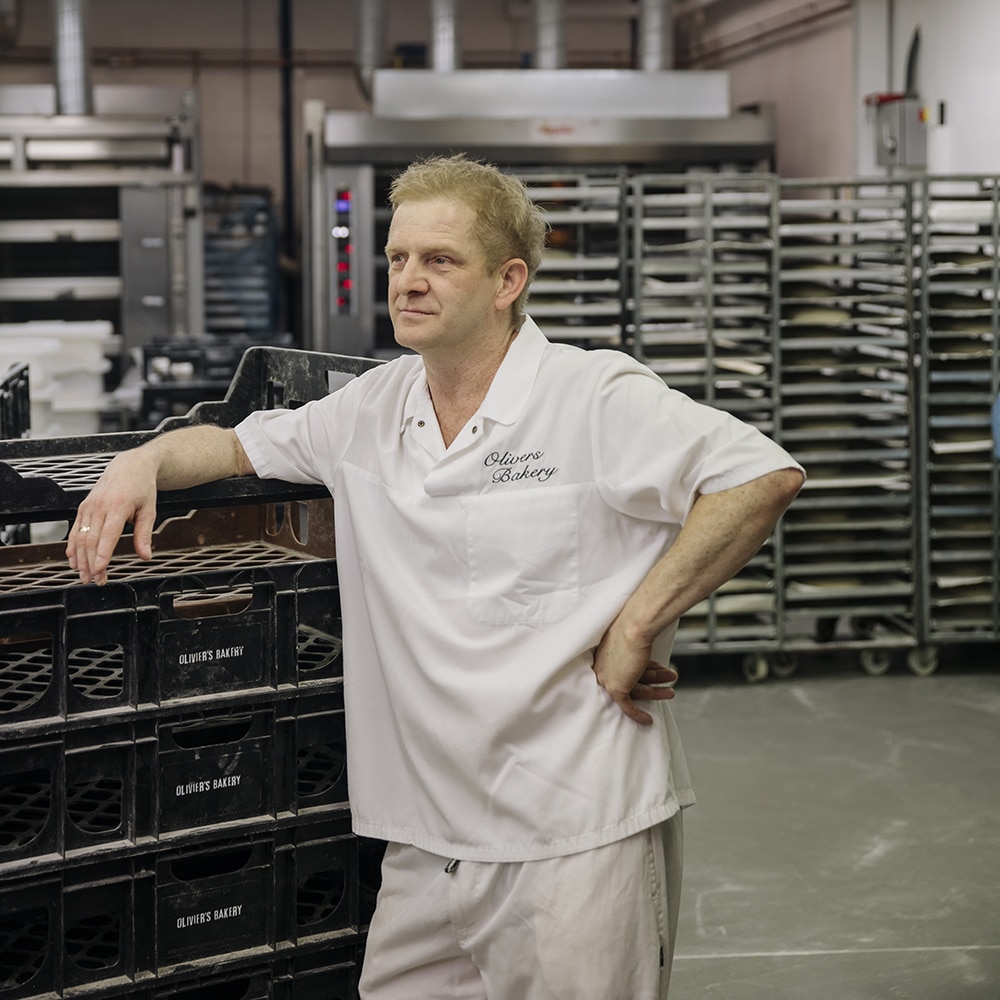
The production of sourdough, he says, is not something you can control at scale. In fact, it’s not something you can control at all – even at Olivier’s level of operation, which he has deliberately confined to selling through markets. “You’re in control of your ingredients and your method, but no one’s in control once the process has started. You do it together: you and your dough.” Working with organic flour from Shipton Mill in the Cotswolds, Olivier finds that every week tells a different story. “Every batch is unique. One week it’s strong, the next it’s weak, the next we have to add more or less water.” To stick to the same recipe week in week out and do everything by machine would be “a complete disaster. You need to get to know the flour, and it changes each week because they mill in small batches.”
This means that each Monday demands a careful renegotiation of the relationship between the bakers and their dough. “You see the colour, you see how it is going to absorb the water, you see how it reacts in the mixer and how it relaxes.” Only once an understanding between a baker and his dough has been established can he set out with confidence on the “small journey” that is baking sourdough.
This connection is all important. The effects of mood on the creative process have often been expounded upon, but rarely as starkly as when Olivier observes that “a happy baker will make good bread. An unhappy baker will struggle.” A chef can feel love for their ingredients, he says, “like a nice carrot, a leg of lamb or beef – but I don’t think they have the same relationship as bakers do. It is a living thing, dough. It is beautiful.”
Olivier’s starter is now 10 years old. “We feed it twice a day, every day. If you go on holiday, someone has to feed it. If you don’t, you won’t have the life to give to your bread.” It’s like a pet, I observe. “No, it’s like a partner,” Olivier laughs. “If you look after it, it will give you the best bit. If you don’t, then you will get trouble.” Sitting in a large plastic tub, the beige and gloopy starter culture that underpins Olivier’s may not be a looker, but it smells rich and full of life. The mixture is malty and warm, bubbling and fizzing as the yeasts and bacteria work their magic. Its potency is palpable. This is a potion that can undermine even the most precise instructions. “I often contrast baking to the work of a pastry chef. With pastry, you follow the recipe and it is fine. If you need to take a break, or stop and change something in the middle, you can easily do it. With the baker, things will never be that precise – and you cannot leave it and then come back to it. Once you start, you have pressed the button and started this living thing, which you have to stay with. You have to keep focused all the time.”
In fact, Olivier was aged just 13 when he started his own career as a pastry chef in his hometown of Saint-Malo, Brittany. “I didn’t like school. My uncle was a pastry chef and every Sunday he would arrive after his shift, at the end of our family lunch, bearing a cake he had made for us. It was always beautiful – and it always tasted amazing,” Olivier smilingly recalls. “My uncle usually went straight to bed after presenting it, but when I saw the faces of everyone eating it, I thought, this man is making all of us happy. It is better than the Lotto,” he continues. “When you win the Lotto, people fight, but people are happy sharing cake together.” He left school at the earliest opportunity and started as an unpaid assistant at a patisserie down the road.
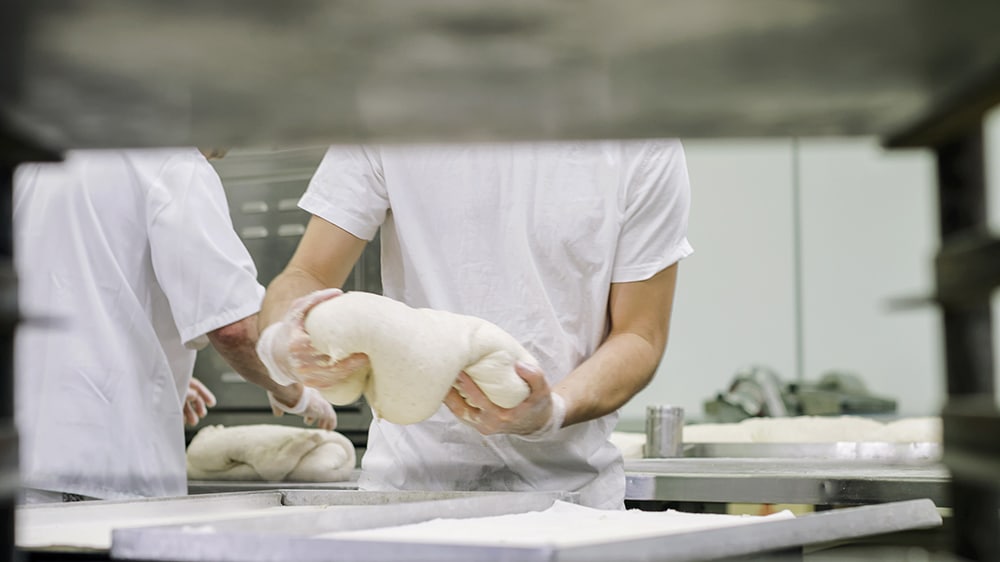
The following year, he was diagnosed with a wheat allergy – “which is why I wear gloves,” he says, holding up his flour-dusted gloved hands. Needless to say, this didn’t faze him and his eyes light up as he describes his subsequent apprenticeship at a patisserie and bakery a short cycle away from his home town. “Every morning I would stop at the port on my way into work and listen to the masts clinking and the waves sounding. It was very poetic. I loved the silence of being the only one awake at that hour. Then as I approached the bakery and smelt the bread and started making pastries – it just took me.” Fast forward a few years and he was working in Greenwich, his London-based chef brother having convinced him to take a job at Didier’s Patisserie, official supplier of fine cakes and pastries to no less a customer than the Queen.
“We made her a birthday cake, and patisserie for her garden parties and other events, like Wimbledon,” recalls Olivier. “My brother went back home after a few years, but I remained in London.” In France, a pastry chef can only ascend through strict hierarchies – “if you are number three, you can only be promoted to number two. If you are number eight, you can only go up to number seven” – but in London Olivier found that, in the world of macarons and madeleines at least, meritocracy reigned. “If you have the talent, you can rise up to the top very quickly, and I preferred the culture here,” he says. “Coming from a small town where everyone knows everyone, it was so nice to be somewhere where you can be what you want to be and wear what you want to wear.” He’d fallen for his wife, a lovely Bulgarian called Valentina; and he’d fallen for the city he now proudly calls home.
Olivier’s eponymous bakery was born out of a curious coincidence of good fortune and good principle: the latter on the part of Olivier and Jan McCourt of Northfield Farm, a now fellow trader. “I’d left my previous job as head baker because the company had been sold and things were changing. They started using pre-mix,” Olivier whispers with the appalled tone of a man describing a crime. “It was not for me. I left with no job to go to – but in a few months, an events company that Valentina and I were in touch with asked us to do a market in Nottingham, and we agreed.” He had no oven. He had no mixer. But he knew Matt Jones, now of Bread Ahead, and he knew that at the time Matt was doing some work with Northfield Farm, which is in Nottinghamshire. “I asked Matt to see if Jan would let us borrow his oven and mixer, and he welcomed us. So, there we started. For the next four days of the market, I think I slept less than six hours. In total.”
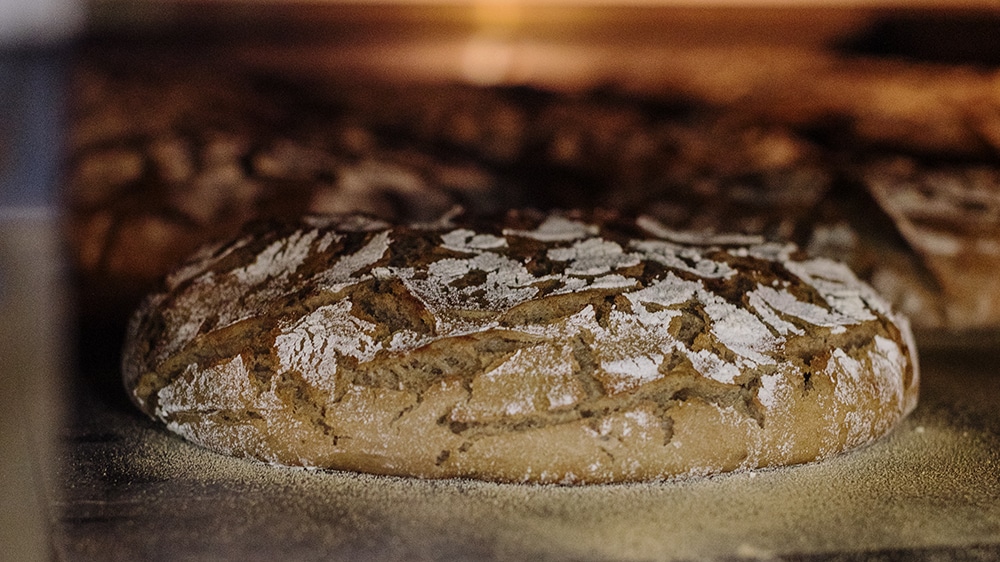
Olivier loves his adopted country, but if there is one aspect in which he remains resolutely French, it is in his attitude toward baking. “I must say it was a bit of a shock to me when I arrived 20 or so years ago. I came here with £50, and all I could afford was a 24p sliced white loaf from Safeway,” he shudders. By the time Olivier’s Bakery launched, changes were already afoot, with small artisans spreading sourdough across the urban peripheries. But the bread culture in Britain was still nothing compared to that of a country built and powered by boulangeries. “The French eat bread every day, with every meal. There is not one flat, house or restaurant where you will not see bread on the table,” says Olivier. He had come here as a pastry chef, and could have made more money by remaining so, “but I got back to bread because I felt I needed to help create change here, a little. I felt people deserved better bread, bread that was good for them, not full of additives and preservatives and other rubbish.”
The feedback from British customers was remarkable. “They came back. They supported us. Even today we still have many of the same customers.” Selling good bread in London has never been too hard – “there are plenty of Spanish, Italian and French people living here” – but it was when the Brits started coming that Olivier knew that something was starting to change. “I don’t know why the food was so bad for so long. I am not a historian, I am a simple baker. But I have seen it change. London is the best place in the world for food now.” He still gets the odd complaint about the price of bread – “only the other week I was in a pub and a guy was complaining. I asked him how much he’d paid for his pint, and he said a fiver. I pointed out that a loaf of my bread was £3.50 and would feed him for a week” – but the majority of Olivier’s conversations with customers centre on how much they enjoy his produce. Besides, as far as quality sourdough bread goes, Oliver’s is not expensive, not by any means. He respects his bread and the colleagues who make it with him, but he wants good food to be as accessible as possible. “I am not looking to steal money from people. I didn’t go into baking to get rich. I am a rich man already,” he smiles, taking out his phone. He swipes through his photos until he arrives at a picture of two young twins, their heads together, grinning at the camera. “See? I am done. I can’t get richer than Oscar and Ophelia. Valentina and I live humbly, we pay the bills, we spend time with the kids and we bake for people. I am a rich man indeed.”
Discover more
The spice series: caraway & dill seeds
Ed Smith takes an in-depth look at the many spices available at the Market. This time: caraway and dill seeds
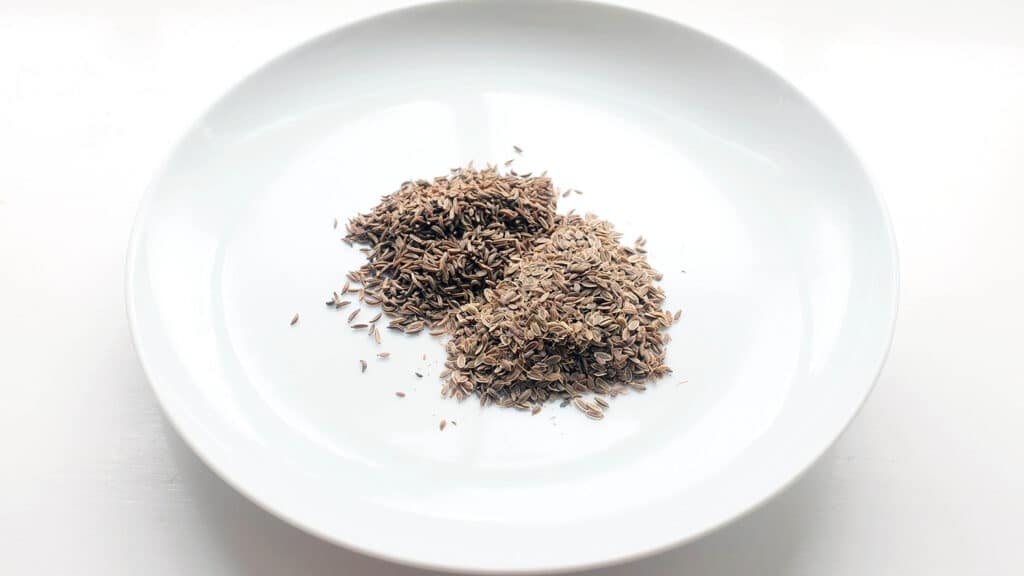

“CARAWAY IS SYNONYMOUS WITH SEED CAKE, TRADITIONALLY MADE IN EAST ANGLIA TO CELEBRATE THE END OF WHEAT-SOWING”
In this article, we look at one ‘seed’ spice that, while well known, is in fact not a seed, and another lesser-known seed, which is worth becoming better acquainted with.
Smelling either of them immediately conjures up memories of pickles and rye bread, as they’re intrinsically linked with the food of Scandinavia, and central and eastern Europe. This may or may not be a good thing for you – while some people love caraway and dill seeds, others can’t stomach them.
Caraway
Many of our most commonly bought spices originated in Asia and were staples of the ancient spice trade from the east. Not so caraway, which though an important spice for centuries, is native to central Europe and the Caucasus. It’s now grown all over the world, including in Egypt and Canada, but the countries where it’s used most often relate to its roots.
Caraway looks like a seed but is actually the fruit of the Apiaceae plant family. It resembles the cumin seed in shape, if perhaps a little darker and less plump, and indeed is sometimes known as ‘Persian cumin’.
There’s lots going on when you taste caraway. People say liquorice (so, anise), which is true. There’s a mustiness and some citrus. I find a bitterness, too, which I suspect is one reason why some people don’t get on with it.
Ultimately, though, caraway is distinctive. It tastes of… well, it tastes of caraway – a pungent flavour that reminds you of cabbage and rye bread, because those things so often involve that very same flavour.
Historically, it was believed to be a particularly good aid to digestion – a factor in caraway being such a common partner to cabbage, fermented or otherwise.
The ‘seeds’ keep very well for a long time and are often just used whole. By toasting them in a dry pan, or tempering with a little oil, some of the aroma will become more pronounced. But it’s not always necessary (or desirable) to do that. You can also grind or pound caraway into a dust as you would any other spice, should you want to avoid having too many things stuck between your teeth.
Dill seeds
Dill seeds are exactly that: the seeds of a dill plant, which appear when dill is left to flower and then those flowers die back and go to seed.
Like caraway, dill is a member of the Apiaceae family (as are chervil, parsley, carrot and anise), so it’s no coincidence that the smell and flavour of these flat, tear-shaped, green-brown seeds is remarkably similar to the aforementioned spice. Perhaps the anise notes and bitterness are softer, and there’s a hint of dill herb too, but these two spices are pretty close and could be used interchangeably.
Unlike caraway, barely anyone knows about or uses dill seeds, perhaps because dill itself is so popular as a herb that it’s generally harvested well before flowering time. Yet the seeds provide an excellent background flavour, and would be particularly successful at times when caraway might seem appropriate, but possibly too powerful.
Dill seeds come to the fore when infused into liquid – whether that’s a brine for fermentation or curing, or an oil or vinegar. They’re also strong as an aromatic in leavened and flat breads. John O’Connell’s The Book of Spice notes that dill seed vinegar is a popular addition to fish stews in Russia and Scandinavia, but also that the seeds pulled an Uzbek recipe for fried flatbread with pork crackling from “what could easily be a stodgy nightmare back from the brink of indigestibility”.
The seeds keep pretty well for a reasonable amount of time and are generally used whole, with no need for grinding. Again, if toasted in a dry pan or tempered in warm oil, more oils will be released.
Culinary uses
Caraway’s classic uses include being mixed into or scattered over Scandinavian rye breads and crackers. It is also vital in those relatively cold countries because it is infused into aquavit, an essential and warming spirit.
This spice is also a key aromatic for pickling brines, particularly for fermented cabbage (sauerkraut), popular in Austria, Germany, Poland and Ukraine.
But caraway is used in other cultures too, including for mughli, a sweet, gooey Lebanese pudding based on rice flour and caraway (plus a hint of anise and cinnamon), which is traditionally made to celebrate births. In India, you might find caraway tempered in oil and spooned over a tadka dal at the last minute before serving.
And in Britain, caraway is synonymous with seed cake, traditionally made in East Anglia to celebrate the end of wheat-sowing, and something that’s been the staple of homemakers since the 18th century. These days, that cake is likely to be paired with some orange or lemon zest, to make it appeal to modern tastes.
Dill seeds don’t enjoy such an obvious culinary history, but could well be used interchangeably with caraway: cabbage, fermented cabbage and rye breads are right up there, and I find flat breads, oils and dairy flavoured with caraway or dill seeds to be a super match for smoked salmon. The spices are also excellent at lifting pork dishes, whether a slow roast shoulder, a Ukrainian stew or a German sausage. A hit of lemon or orange is often beneficial – something about the acidity prevents caraway or dill seeds from being overpowering. And I’m also a huge fan of these seeds in or on sharp, lactic cheeses, particularly when honey is involved as a condiment.
Specific recipes to look out for
It has been pretty tricky tracking down recipes using dill seeds, but you could swap them for caraway in any of the following:
— My bible for all things interesting is Bar Tartine: Techniques and Recipes, and it comes up trumps in the hunt for these spices. I love the idea of caraway oil – an infusion of toasted, crushed seeds in sunflower or grapeseed oil. But maybe I love the idea of caraway-infused honey more, particularly when it’s to be drizzled over some feta, or a cheesecake.
— For something a little bit different, consider baking the beetroot and caraway (or dill seed) cake in Hugh Fearnley-Whittingstall’s Love Your Leftovers.
— How about making your own sauerkraut? Skye Gyngell’s version in Spring uses red cabbage rather than white, and requires 1 tbsp caraway seeds. As with all things fermented, you’ll need a little patience before you can sample your prize, but I think it’s worth it. — If you’d prefer more immediate caraway satisfaction, have a look at my Tiroler gröstl recipe. This Austrian fry-up of potatoes, bacon and an onion, topped with a fried egg, seems pretty similar to an English morning-after recovery dish. But a spoonful of caraway seeds transforms the flavours, lifting it, and ultimately making what I think is the very best skiers’ lunch available.
What it takes: Melton Mowbray pork pies
Paul Hartland of Mrs Kings Pork Pies on the challenges involved in the making of an east Midlands classic


“NEXT TIME YOU ENTER TASTE CROATIA, LOOK UP – THERE’S OFTEN A WHOLE PRSUT HANGING FROM THE CEILING”
Through this series we’ve discussed cured meats in general, Italian regional variations at length, and the two other giants of European curing – Spain and France – in detail too. Hopefully I’ve added context to what you already knew and loved, and the articles provided some encouragement to try a few slices of something new next time you walk around the Market (the rolled pancetta at Bianca Mora is looking particularly fine (and fatty) at the moment…).
While those three regions are the places most Brits think about when it comes to cured meats, there’s more to it than salumi, charcuterie and charcuteria.
Germany and Scandinavia in particular have fine traditions of curing – often with a smoky edge, most likely because their climate necessitated that element more than the natural curing chambers provided by the caves of Emilia-Romagna and the Iberian Peninsula. At the Market, another region is also represented: Croatia.
Croatian cuisine is varied and regional. To knowingly over-simplify things: food in coastal areas take a distinctly Italian and Mediterranean turn, with olive oil, rosemary, sage, bay leaf, figs and truffles; further inland, the influence of Hungarian and Turkish cuisine is clear, so think paprika, black pepper and lard for cooking (rather than olive oil). One thing is consistent, though: traditional cured meats.
Pršut
Next time you enter Taste Croatia, look up – there’s often a whole pršut hanging from the ceiling. Pršut is the dried rear leg of a pig so, basically (but not specifically), the same thing as prosciutto or serrano ham.
I am told that you will find pršut across Croatia, though the two areas that this meat tends to be produced are Istria and Dalmatia. These are coastal regions that benefit from climatic conditions which are favourable to curing and air-drying pig’s legs, with both steady winds from the Adriatic and dry winds from coastal mountains.
Dalmation pršut is lightly smoked for flavour, but otherwise simply salted, and often matured for a couple of years. Istrian pršut is unsmoked, but (unusually for this style of meat) skinned before the curing process begins and seasoned with pepper, bay leaves and garlic, and aged for a year.
Kulen
Kulen is like a very meaty, slightly crumbly chorizo seasoned with paprika, garlic and white pepper. We need to head east and inland to understand it and, again, there are a couple of different varieties.
Both are oval shaped and large, often up to 10cm in diameter, on account of the fact the sausage meat is stuffed into a pig’s intestine. But kulen from Baranja, the Croatian-Hungarian border region, is smoky and spicy and paprika-heavy; kulen from Slavonia, on the other hand, includes already-cured bacon among the pork mince, and less paprika.
Wild boar, venison and salami
Other meats exist beyond the stars of kulen and pršut. As with the other regions we’ve discussed, premium products and styles develop over time, but the prime reason for curing was always to preserve the meat of an animal for as long as possible, so every bit would have been used.
As one might expect, small salami-style sausages are prevalent. At Taste Croatia you can find salamis from Istria featuring Istrian black truffles, and also plainer ones using wild boar. The flavours and styles that differentiate regional salamis are so often based on meats or seasonings local to the sausage makers, and it’s no different here.
Istrian artisans have also turned their hands to curing wild venison and boar in a prosciutto-style for slicing – each really worth sampling.
A view from the stalls: Germana Forlenza
Ten insights into life at Borough Market from Germana of Gastronomica
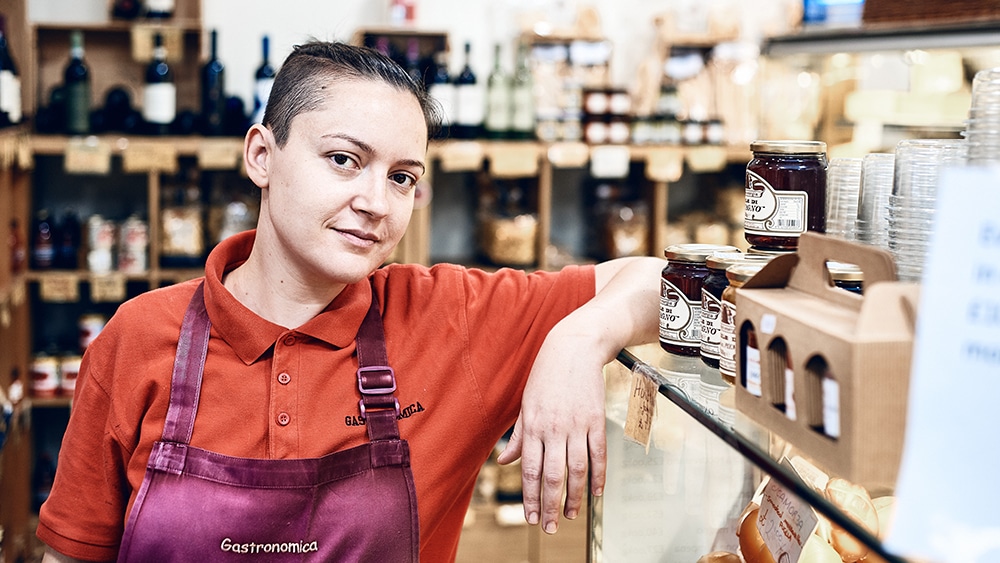

“WINTER IS MY FAVOURITE SEASON IN THE MARKET. IT IS THE BEST TIME FOR EATING CHEESE – AND I ABSOLUTELY LOVE CHEESE”
Interview: Viel Richardson / Image: Christopher L Proctor
1. I knew while I was still at school that I wanted to work in restaurants and hotels. I started in the kitchen but soon realised that I wanted to move front of house because I liked dealing with people – that’s why I love this job so much.
2. I decided to come to London because of a missed opportunity. I had a chance to work in a hotel in northern Italy and went to the interview with a friend of mine. There was only one position and they gave it to my friend because he could speak better English. So I said, “Okay, I will go to London for three or four months to improve my English.” I never went back. I started at Borough Market in 2009.
3. Working here, you have the chance to talk with customers and build relationships with them. For example, an Australian regular was here earlier and he stayed for half an hour talking about his life, what he’s up to, it’s really nice. At Gastronomica, we have regular customers from many parts of the country, they know a lot about food and they like to try different things. The nice thing is every day we have something different to recommend for them.
4. It is really important for me to know our products. I need to know the seasons, how things should look and taste. Sometimes the transport might damage the product and I need to be able to spot when this happens, whether it has affected the look, flavour or texture. I need to know the shelf life and how to store things. I love this level of involvement. This is why I am still here after nine years.
5. For me, the nice thing about autumn at the Market is the way it comes to life again after the summer when people are on holiday and things are a little quiet. You see the energy beginning to build up again.
6. One of the things I would recommend is a cheese called testun al barolo, made with 40 per cent goat’s milk and 60 per cent cow’s milk. Before it is aged, it is covered all over in the grape must left over in the barrels from making nebbiolo wine. It is a very rich cheese, with the dark red colour of the must infusing the cheese with its flavour and the edges with its colour. Gongonzola dolce is also wonderful in the autumn – its intense tang goes very well with the sweetness of the pears and apples that are also coming into season.
7. Winter is my favourite season in the Market, though. It is the best time for eating cheese – and I absolutely love cheese: eating it and talking about it. Once I start talking about cheese, it is difficult to get me to stop.
8. One of the best things about working here is the relationships you build with other stallholders. The guys from Northfield Farm, who sell wonderful meat, are good friends. The people at Ginger Pig, Brindisa, La Tua Pasta. We buy some products from Grovers, the wholesalers. And Turnips – they are very good friends of my boss.
9. There is a real community with the traders. We all buy products from each other. When we have new products, we ask each other to come and try them. You discover so many new things this way. We usually meet other traders after work on Saturdays to have a beer and talk about the week.
10. It’s very hard to leave Borough Market because working here is unique. I have seen people leave for other jobs but many of them return. It’s completely different to anywhere else. Each morning I spend half an hour getting through the Market and into work. I drop by to say hello to my friends from other stalls. Every evening, I leave from the other side, because I need to say hello to the people working over there. It’s a kind of routine: if I don’t, people will wonder what’s happened.
What it takes: Melton Mowbray pork pies
Paul Hartland of Mrs Kings Pork Pies on the challenges involved in the making of an east Midlands classic


“LIKE ANY FRUIT, ONCE IT HAS BEEN PICKED AN OLIVE WILL START TO LOSE SOME OF ITS CHARACTERISTICS”
Interview: Viel Richardson
What is extra virgin olive oil?
It is very simple. To make extra virgin oils, the olives are crushed with a press. A separator device then separates the crushed olive pulp from the oil itself. That is the end of it – no other processes are allowed. While they are all referred to under the umbrella of ‘olive oil’, there is a massive difference between extra virgin olive oil and generic olive oil. In the generic olive oil industry, they take the olive pulp and crush it again, then introduce additives to clean and get the most out of the oil that has been produced.
When do you harvest the olives?
There is only a short window when they will be at their best, so you have to keep a close eye on the olives. The harvest can start any time between early October and early November, depending on local micro-climate and the environment where the olive trees are located. It is quite possible for different olive farms in the same region to be ready to harvest at slightly different times. Then there is the variety of olive, which may have an impact on the harvest. Part of the skill of the farmer is knowing exactly when to start.
Why is timing so important?
You have to pick the olives when they have just started to ripen and are still green. When you do this, you get just half of the oil that you would get if you left them to fully ripen, but the quality of the oil is much higher. There is a trade-off between higher yields and lower quality. Picking them just as they start to ripen means they are richer in all the characteristics you want. It is also better to take them from the tree and not wait for them to fall to the ground.
How do you pick the olives?
The most efficient way to harvest olives is to shake the fruits until they fall. Some farmers use machines that shake the whole tree. We do not use that method, because it places the tree under a lot of stress. Instead we use a mechanical pole, which works as an extension of your arm. The pickers use this device to grab a single branch, which they then shake. This is much gentler on the tree, while also being safe for the pickers. Olives used to be harvested by people climbing ladders, but this could be dangerous, as the nature of the soil and the terrain can make the ground unstable. Accidents were common, with people falling from ladders. Using the harvesting pole is a much better method.
What happens after you pick the olives?
We press them the same day. The sooner you press them, the better. We start the harvest at around 6am and aim to be finished picking by 11am. We then transport the olives to the mill, where they are separated from the leaves and loaded into the olive presses. It is a long day – it can go on until midnight.
Why the hurry?
There are two main reasons for this. Like any fruit, once it has been picked an olive will start to lose some of its characteristics. But there is a more technical reason, too: the olives are taken to the mill in containers that weigh 50-60 kg. If they are left in these overnight, the ones at the bottom with no air circulation will start to ferment, and this is something you really want to avoid. That is why you have to do the whole thing in one process.
How are they pressed?
They are loaded into a crushing machine, where the actual crushing is done by a set of very heavy stone wheels that roll around a metal bin. The resulting paste is spread over a series of fibre discs, which are placed on top of each other in a pressing machine. The piles of discs are then slowly pressed to extract the oil. Any water in the resulting oil is drawn off, and then that is it: you have unfiltered olive oil, which is cloudy in appearance, but can be sold as it is. The freshest unfiltered extra virgin olive oil is called the ‘novello’ oil and is really sought after.
Most oils go through one last process, which involves filtering them through a fine mesh. This produces the clear extra virgin olive oil most people are familiar with. To give you an idea, we get about 10 per cent of the weight of olives as olive oil. The best season we ever had was 15 per cent, but we have never gone above that. If we were to delay for a month, we could get over 20 per cent, but the quality of the oil would be lower.
What happens next?
We store the oil in stainless steel tanks in an oxygen-free atmosphere that prevents any changes to the flavour. Then it is bottled, and that is it. We are based in Puglia, way down in the south of Italy, so it takes seven days for our olive oil to reach Borough Market.
How would you describe the taste of a good extra virgin olive oil? A good early harvest oil will always have a peppery kick. Sometimes people have asked me if that is the sign of a cheap product, but actually the opposite is true. That kick is something you want – it means that the olives were very green when harvested. If the olives have been left to ripen and darken, the oil is sweeter. With good extra virgin olive oil, you do not need much because it can overpower a dish. Just a few drops will enhance the food with some really wonderful aromas and tastes.
Read more about The Olive Oil Co.
Hive mind
The best honey, like the best wine, offers a clear expression of the place that produces it. To understand how., we headed to an apiary on the Swedish coast, source of one of the remarkable honeys sold by From Field and Flower
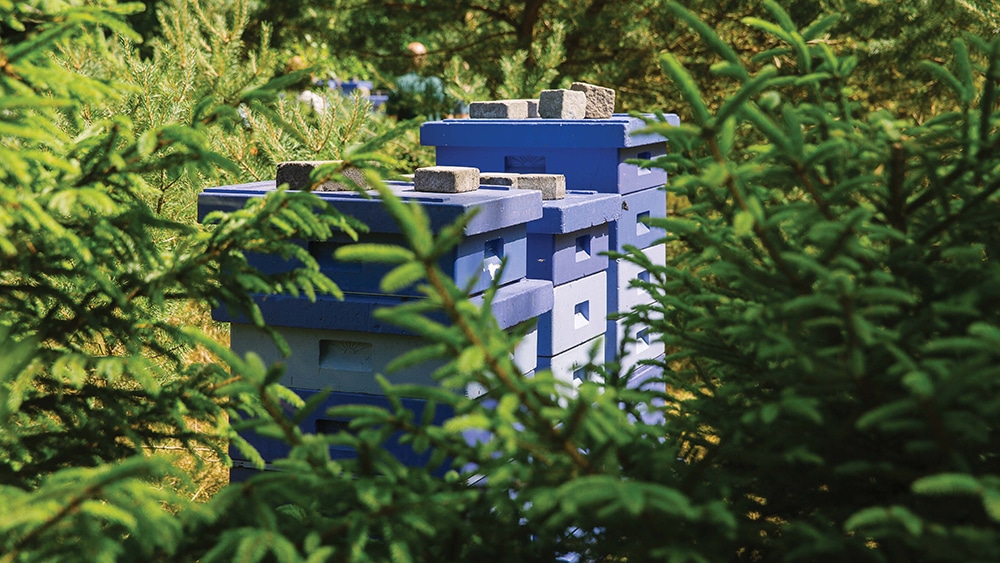

“DIFFERENT FLOWERS YIELD DIFFERENT HONEYS; INDIVIDUAL APIARIES ARE UNIQUE, JUST AS SINGLE VINEYARDS ARE”
Words: Clare Finney / Images: Joseph Fox
“We have one nation to thank for having a language relating to honey tasting, and that’s Italy,” says Viktoria Bassani warmly, looking admiringly toward Stefano. The Piedmontese co-founder of From Field and Flower smiles back proudly. Though he did not of course invent this honey lexicon, in spearheading the sale of honey varietals at one of Europe’s biggest food markets, he has certainly contributed to his country’s sweet and golden legacy. The pale, shimmering ‘pearl’ honey that Viktoria produces is just one example of the many highly distinctive and wildly diverse honeys from around the world sold at the stall in Borough Market.
That’s why we’re here: honey – like wine, coffee or cheese – is at its best an expression of the land and the people that produce it, varying dramatically not just between landscapes or regions, but between each collection of beehives. And Viktoria is one of the most passionate proponents of varietal honey to be found this side of the Alps.
Viktoria has 80 hives, divided between many different apiaries around Malmo, Sweden – which is where we meet before travelling onto an apiary of hers near the coast. Her daughter, Isabel, joins us. Though Viktoria is the pioneer who researched, built and founded the bee business, in recent years it’s become a real family affair. Throughout long school and university holidays, Isabel has helped her mother extract, jar and label the honey from each apiary. Marcus, her teenage son, is responsible for the website, from which Viktoria sells her honey to Sweden and beyond – including, surprisingly, Qatar. “There is a real appreciation of honey over there,” she explains to our bemused faces. “They love it a lot, and it’s hard to come by.”

It’s testament to Viktoria’s ethics that she initially refused this lucrative opportunity on environmental grounds. “When I first started getting requests I said, ‘Is there no honey produced in Qatar?’ They told me it was almost impossible to produce, because it is mostly desert.” Eventually Viktoria conceded, providing it was shipped rather than flown, to reduce the carbon footprint. “It takes longer, but you know – honey can last for millennia,” she smiles. This claim was put to the test by archaeologists excavating the Egyptian pyramids, who found pots of honey that were still edible 4,000 years on, thanks to its high sugar content.
Of course, we’ve refined our craft since then, with purpose-built hives, extractors and, at the extreme end, industrial production. But the bees still do the bulk of the work. “That is what I get excited about,” says Viktoria. “The bees have perfected their methods over thousands of years. I just have to tune in and listen to what they are doing.”
Tune in she does – almost literally, when you consider that the ‘buzzing’ of bees is the sound of them evaporating the water in the nectar they’ve collected by vibrating their wings. “At 20 per cent or less, it’s honey,” says Viktoria. The process is difficult to understand without lifting the lid on a beehive and taking a detailed look at the world therein: the tessellated web of honeycomb, the worker bees bringing nectar, and the constant, mesmeric humming of thousands of working wings and bodies. “I think it’s a lovely sound,” says Viktoria, pointing to a honeycomb cell that has just recently had a filmy wax ‘cap’ layered on top of it – a signal to the beekeeper that the frame is ready to take away. “Once they have started to cap the honeycomb, that means the bees know it is honey, and stable for the next thousand years.”
We huddle closer, mindful of the new-born bees that pose the only real risk to humans opening a bee hive. “They cannot fly for 10 days after birth, so if they fall out of the hive when we open it they want to crawl back in again.” If they’re unlucky, they’ll crawl up your leg by mistake; if they’re really unlucky, you’ll move so sharply they’ll be prompted to sting you. “They do try to avoid stinging if possible – because if they sting you, it kills them,” says Viktoria, semi-reassuringly. Fortunately, the heavy bee suits and wellington boots we’re wearing will protect us from everything except the heat – as searing in Sweden this summer as it was back home – and the wild boars.
The wild boars are a recent development. Viktoria has yet to see them, but has been informed of their presence by a farmer who hosts some of her apiaries. It could be worse – the repopulation of bears in the north of the country has created a growing problem for some of Viktoria’s peers, forced to fend off aspiring (and considerably more aggressive) Winnie the Poohs. The heatwave is also new. It’s a heady 26C and it’s been like this for two months without pause. “It’s unheard of here,” she says disbelievingly. While Viktoria is worried about the lack of rainfall, the high temperatures are a boon for both the quantity and flavour of her honey.
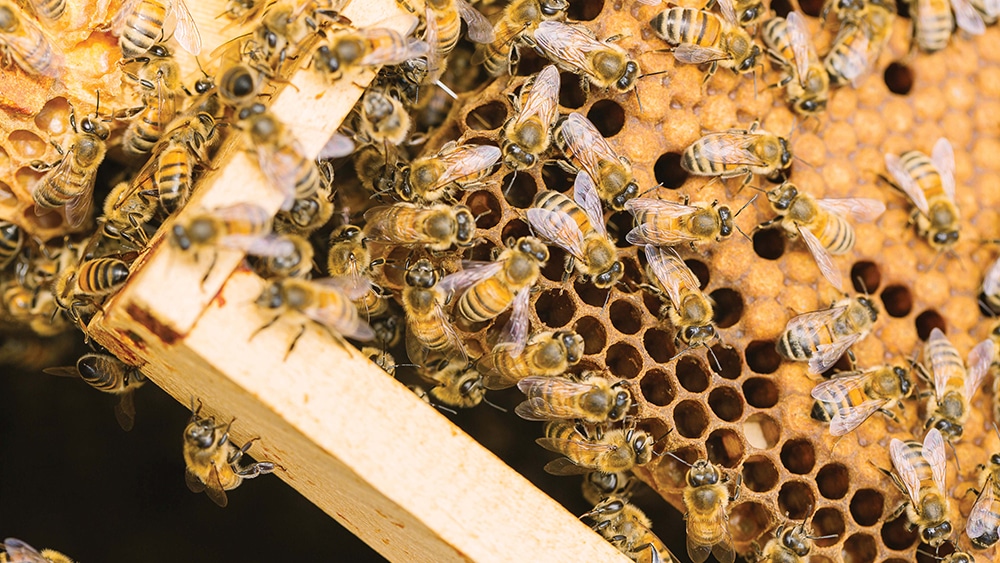
“We have already collected far more than we would in a normal season – and it’s mid-July,” she says, wonderingly. “A normal season lasts to the end of September.” The hives are big, unusually so, and the honey uncharacteristically flavourful. “Usually in this part of the world the early season honey hasn’t had enough time to develop rich flavours. It’s deliciously aromatic,” she continues, “but it is often quite neutral.” She likens it to growing strawberries: “The longer they are on the vine, the more flavour they will develop. They don’t taste as strong if they develop quickly. Likewise with honey: we get more intensely flavoured honey at the end of the season.”
Though produced early on, the pearl honey is delicious, interjects Sam Wallace, From Field and Flower co-founder and Stefano’s partner in life and business. “It’s the first one we encourage new visitors to the stall to taste, because it is so delicate.” Still, she’s as eager as any of us to try some of 2018’s heady ‘heatwave’ honey.
Viktoria isn’t collecting today. Ours, she says, is more of a “social visit”, allowing her to check in with her bees and offer me, Sam and Stefano a behind-the-scenes glimpse of the bee industry. The colour of the hive strikes us first: a bright lavender blue which seems both out of place and yet curiously at home, dappled with morning sunshine in the pine forest clearing. “The bees prefer blue and purple flowers, so I thought, why not adopt blue for the hive? I like blue,” she laughs. Less obvious to the eye are the hive’s environmental credentials. “These will last for 35 years, so they’re the most sustainable option, and using plastic frames inside rather than timber allows us to recycle the bees’ wax for them.” Just how this works will become clear later.
These bees are busy. This one apiary has produced more honey this season than Viktoria’s whole collection did last year – and shows no signs of stopping when we visit. Each tray is laced with honeycombs, which the house bees are busy either filling with nectar or capping with wax. “Foraging bees come back with their load in what we call the ‘honey balloon’,” says Viktoria, “and they want to get rid of it so they can fetch more. They dump it onto the house bee, who brings it to the right cell and starts reducing the water content.” Knowing what we know now, the background buzz suddenly seems less of a lazy hum, more the sound of richly purposeful energy.
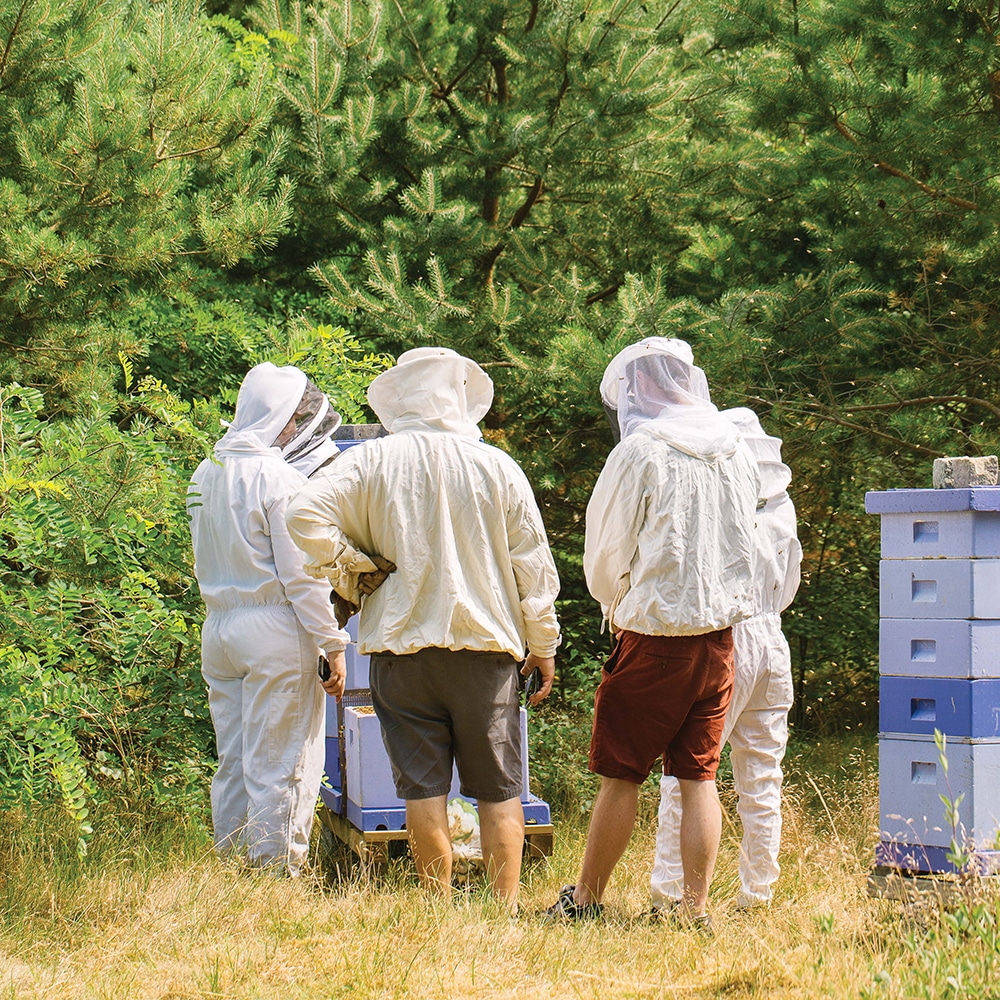
“At this time of year, it will be heather honey. A lot grows on the beach nearby – the sea is only 200 metres away,” she continues. Maybe it’s her astute palate, having worked as a sensory wine analyst before swapping vineyards for apiaries, but Viktoria maintains she could recognise the apiary’s honey blind, on account of its subtly salty taste. “My colleagues call it ‘beeroir’ – like terroir for wines,” she laughs. “I’m not sure it works as a word – the English will think it’s to do with beer and be very confused. But we do need to start talking about the way honey is affected by microclimate and geography.”
Texture. Colour. Viscosity. Scent. All this before even tasting the honey, which can be as varied as wine in its flavour profile and mouthfeel. “When I first started, all I could think is, it’s sweet. I couldn’t possibly understand how I could taste anything beyond that,” Viktoria recalls. Even her extensive experience in the wine industry could not help her when it came to writing tasting notes for honeys. She looked to Italy, where researchers had developed a colour chart, connecting flavours and shades to nectar sources. In Bologna, three postgraduate students had written a paper on honey varietals. She read it avidly, together with a seminal book by Eva Crane, an English beekeeper and mathematician. “Dr Crane passed away in 2007, just when I started, but I knew by then that I wanted to focus on varietals – to bring the variety of flowers in nature into the jar.”
For many people – or at least, those who don’t yet frequent From Field and Flower – the concept of honey varietals is still an unfamiliar one. All the honey you see in the supermarket will have been blended, with the bigger companies blending honeys from hundreds of apiaries across Europe. These honeys are pasteurised: heated up to create a cohesive texture, and to eradicate any variations in taste. “The main thing is to create a consistent, low cost product,” explains Sam. “Any beneficial bacteria will be killed off by the heat – and you certainly won’t taste any variation.” That’s fine if you just want straight-up sweetness to cook with, say, but it’s of little interest to someone as steeped in the concept of terroir as Viktoria.
Different flowers yield different honeys just as different grapes yield different wines; individual apiaries are unique, just as single vineyards are. Their ‘beeroir’ cannot be replicated by an apiary 20km away, or even by the same apiary the following year. “Every season is a novelty to me,” beams Viktoria. Come harvest time, the honey is extracted, jarred and labelled to reflect its time and place. Viktoria extracts the honey from the frames with as little mechanical intervention as possible. “With experience I’ve found it affects the flavour slightly, and I don’t want to produce bland honey. We have 80 hives and that is the way I like it to be.”
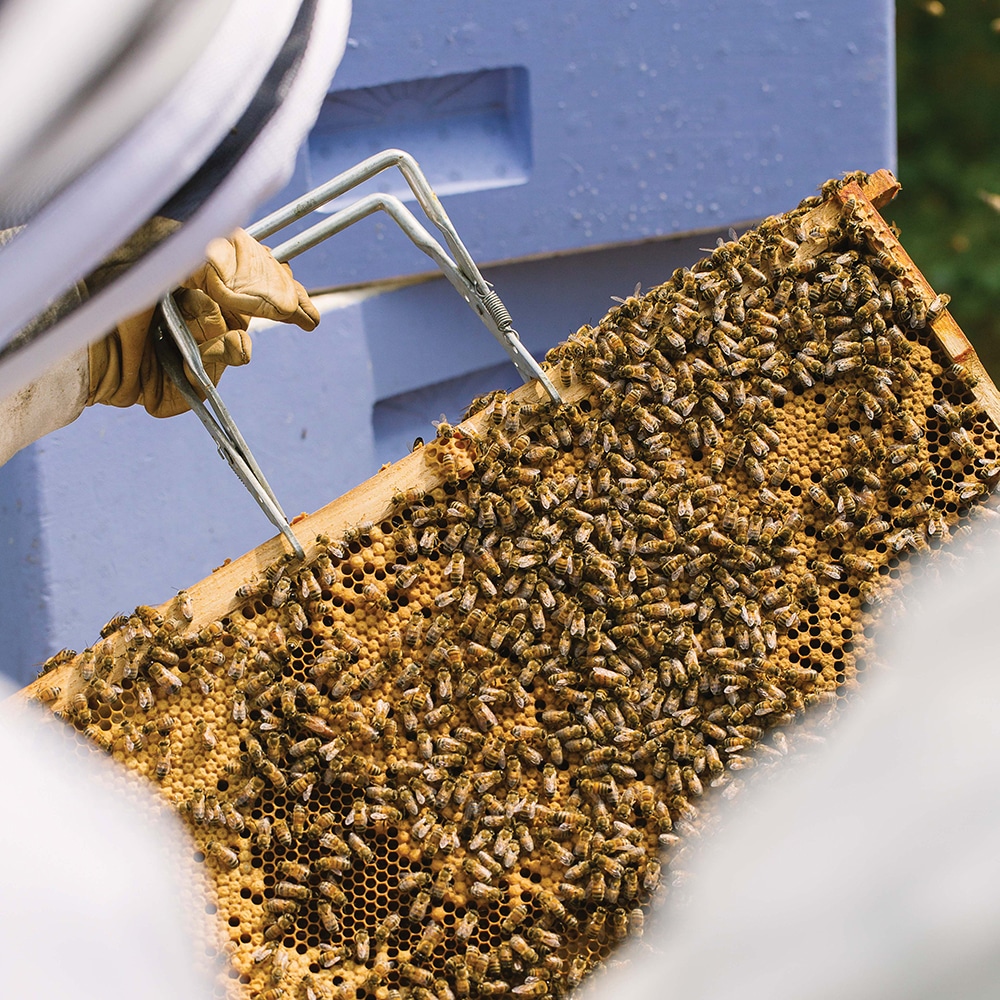
Carefully, Viktoria closes up the hive. Some casualties are inevitable: “I cannot possibly stand here all day waiting for them all to move away from the edge, though I do try to shift as many as possible.” The bees themselves “don’t even think about it. They treat the hive as one organism, one body,” she continues – making it all the more remarkable that they know Viktoria by scent and, according to research just published in Germany, by sight. “The average bee lives for four to six weeks. It is like an inherited knowledge,” she marvels, as she calmly replaces the final frame and puts the lid on it. We make our way back to the trucks, peeling off the white, linen layers as we walk, and set off toward the processing unit next to Viktoria’s house in the countryside.
“It’s quite old fashioned,” she grins as, in food hygiene gear complete with clogs, we step into her shed-come-honey plant. On one side, honey frames are stacked ready for extraction. Next to that, stripped honeycombs lie seemingly abandoned in a sticky, craggy mound. The extractor sits in front of us. “She’s called Francesca because she’s from Italy, and she does things the way she wants to do them. Not the way we want,” Viktoria laughs, turning the machine onto its lowest setting. Francesca’s stainless-steel tummy rumbles as the centrifuge spins slowly, with the honey-filled frames attached to the central structure. “It’s very simple. They spin around, the honey hurtles out of the wax onto the walls, slides down to where this tap is and comes out.”
Viktoria stops Francesca, opens up a tap near the extractor’s feet, and smiles as we exclaim at the heavy stream of gold pouring smoothly out of it. “Again, again!” we cry, when the honey eventually slows to a trickle. Viktoria happily obliges, sending Francesca into another gentle spin. “There is lime tree honey in here. Can you smell it?” she says – and sure enough, when she opens the tap a distinct citrus scent hangs in the air. This variety is not for blending. Come tomorrow, it will be put into jars – unfiltered, because “removing those trace bits of pollen removes so much flavour” – and labelled with today’s date and the location of the apiary from whence it came.
The now-empty honeycombs, meanwhile, will be melted down for their wax. “I prefer the look and feel of timber frames, but the plastic offers a closed circuit,” Viktoria tells us. “We don’t have to send our wax away. We just melt it down overnight, roll it onto plastic frames to go back in the hive, and the bees can reuse it.” They can of course produce more wax from their glands, “but it’s hard work for the them. To make one kilo of wax they need to consume nine kilos of honey.”

She’s waiting for a cool night. We all are at this point in the summer, but it particularly matters for Viktoria in order for the wax to set on the frames, and for the creation of the pearl honey sold by From Field and Flower – an opaque, thick-set honey, the creaminess of which results from painstakingly stirring, for around 10 hours over the course of six or seven days. “For stirring, we need the honey to be at the perfect temperature. If it’s above 25C we have to halt the operation,” she says, “and that has been a challenge this year!”
They even contemplated stirring at night, “but no one wanted to do that,” smiles Viktoria. Later on, she shows us a basin of half-creamed honey, its contents ivory-white and steeped in scent. They stir by hand: too vigorous a stir would release the delicate aroma compounds. Unlike her other honeys, the pearl honey does have to be filtered for stray bits of pollen whose presence would prevent its transformation from liquid gold to dense, sweet cream. The creaming of honey to prevent it from crystallising is an old Scandinavian tradition, but Viktoria has over the past 12 years elevated the technique to new heights, resulting in the gloriously smooth product that she calls ‘pärlehonung’.
We taste it in the garden, alongside various other honeys from her apiaries in the centre of Malmo (“bees thrive in the city – they get such variety in the parks”), on organic farms, and of course from the one we visited. Last year’s pearl honey is velvety and delicate; the lime honey we saw coming out of Francesca is almost leaping with flavour; the urban honeys are as multi-faceted and complex as the environment that yielded them; and the dark, jammy heather honey is brooding and almost bitter-sweet. Their differences go beyond language – or at least, they go beyond my language. I am no more qualified to talk in detail about these honeys than I am to intrude upon a conversation between Swedes or Italians. I can taste them though – and I can, now I have seen it up close, appreciate the hard work both bees and beekeeper put into preserving these snapshots of nature’s inimitable, infinite variety.
